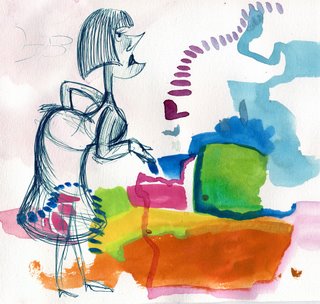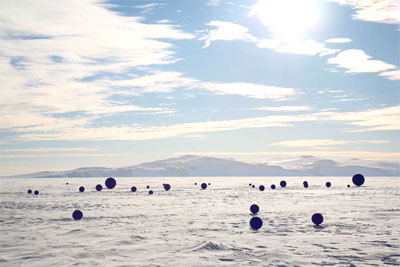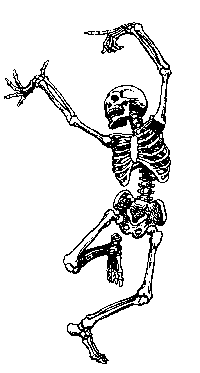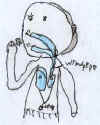Archive for the ‘Neuroplasticity’ Category
January 7, 2009
Greetings Somanauts!
Here’s the new year’s update on the free GGI teleseminar: Yoga and the Brain!
First to say, the teleseminar is filling up with folks from different countries, proving the global interest in movement meditation and the brain!
With that in mind, the teleseminar is scheduled for the following dates and times below:
U.S. and U.K. residents:
Date: January 12, 2009
Time: 9 a.m – 10 a.m., Pacific Standard Time
For Australian and AsiaPacific Residents:
Date: January 13, 2009
Time: 10 a.m. (Sydney time zone)
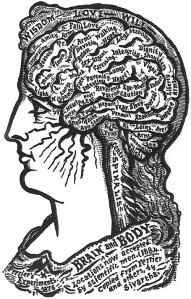
A recap of the teleseminar goal and content:
Who should take this teleseminar? Anyone working with, or interested in, the neurological effects of restorative or high performance training including allied health workers, public policy makers, physicians and physician assistants, psychiatrists, ADHD specialists, social entrepreneurs in health and wellness, and of course, all members of the somatic, yoga, meditation, athletic and martial arts community. (Global citizens please note: The teleseminar will be conducted in English.)
What will I learn: This teleseminar introduces the core neuroscience concepts central to any top quality training program that teaches yoga and movement meditation. Concepts include: neuroplasticity, immersive attention, somasensory integration and more.
What are the key benefits of this teleseminar?: You will leave the teleseminar energized and armed with a grand pattern of understanding how neurologically important your work is as a proponent of yoga movement and meditation. Seminar discussion is particularly valuable for anyone dedicated to improving the development and integration of brain, body and mind.
How do I join this free teleseminar? Simply write to 2docgee@gmail.com with the word “yes, ” along with your state and country of residence. Follow up information will be sent to you at your given email address.
Looking forward to your participation!
May the Breath Be With You!
Dr. G., Founding Director, The George Greenstein Institute, creating a sustainable future by coaching bodies, brains and minds!
The George Greenstein Institute is dedicated to serving the public good, by offering up to date, brain-based education in health, creativity and performance world wide.
Tags:Exercise and the Brain, Meditation and Neuroplasticity, Neuroplasticity, Neuroscience, SpaceSuit Yoga teleseminar, Yoga and the Brain, Yoga and Wholistic Health
Posted in Advances in Neuroscience, Ancient/Future Technologies of the Body, Brain, Brain Technologies, Brain Training, Breath, Cognitive Science, Consciousness, Contemplative Education, Mind/Brain Training, neuroleadership, Neuroplasticity, Neuroscience, SpaceSuit Yoga, Uncategorized, Whole-Brain Neuroscience, Yoga | Leave a Comment »
December 31, 2008
The Platform: The George Greenstein Institute rings in the New Year with a free teleseminar: Yoga and the Brain!
The Twitter: 2008 proved movement and meditation are great for improving the embodied brain!
The Big Idea: Take your yoga, martial art, meditation, wellness or neuroleadership practice to a new level by learning about the key prime mover: the brain!
If 2008 proved itself as the Year of the Brain, 2009 will surely follow with raising awareness of we can change our brains, our bodies and our minds!
To that end, The George Greenstein Institute is proud to offer the first of its 2009 teleseminars: “Yoga and the Brain,” taught by yours truly, Dr. G.
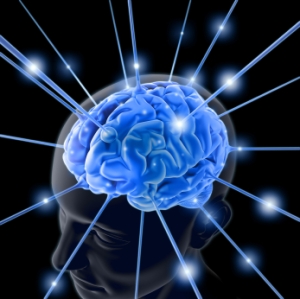
Who should take this teleseminar? Anyone working with, or interested in, the neurological effects of restorative or high performance training including allied health workers, public policy makers, physicians and physician assistants, ADHD specialists, social entrepreneurs in health and wellness, and of course, all members of the somatic, yoga, meditation, athletic and martial arts community. (Global citizens please note: The teleseminar will be conducted in English.)
What will I learn: This teleseminar introduces the core neuroscience concepts central to any top quality training program that teaches yoga and movement meditation. Concepts include: neuroplasticity, immersive attention, somasensory integration and more.
What are the key benefits of this teleseminar?: You will leave the teleseminar energized and armed with a grand pattern of understanding how neurologically important your work is as a proponent of yoga movement and meditation. Seminar discussion is particularly valuable for anyone dedicated to improving the development and integration of brain, body and mind.
How do I join this free teleseminar? Simply write to 2docgee@gmail.com with the word “yes.” Follow up information will be sent to you at your given email address.
With all neurotransmitters sparking, I wish everyone a happy new calendar year. May 2009 be the year we all resolve to consciously rewire our brains! Gong Ji Kuai Le!
Dr. G., Founding Director, George Greenstein Institute, creating a sustainable future by coaching bodies, brains and minds!
 Bio: M. A. Greenstein, Ph.D. is the “chief brainiac” of The George Greenstein Institute. An internationally respected author, keynote speaker and advocate for visual and somatic education, Dr. Greenstein has dedicated herself to advancing somatics and sciences and the field of neuroleadership by reframing the matrix of research and training to include neuroscience and fields of inquiry that address wholistic approaches to improving health, innovation and performance (Get HIP!) Dr. Greenstein will be teaching meditation at TED 2009, and moderating a panel on Social Entrepreneurship at the upcoming 2009 Creativity conference: Worlds in the Making!
Bio: M. A. Greenstein, Ph.D. is the “chief brainiac” of The George Greenstein Institute. An internationally respected author, keynote speaker and advocate for visual and somatic education, Dr. Greenstein has dedicated herself to advancing somatics and sciences and the field of neuroleadership by reframing the matrix of research and training to include neuroscience and fields of inquiry that address wholistic approaches to improving health, innovation and performance (Get HIP!) Dr. Greenstein will be teaching meditation at TED 2009, and moderating a panel on Social Entrepreneurship at the upcoming 2009 Creativity conference: Worlds in the Making!
Tags:Adult Neuroplasticity, Exercise and the Brain, M. A. Greenstein, Meditation and Executive Function in the Brain, Neuroplasticity and Learning, Neuroscience of Attention, Social entrepreneurs and the Brain, SpaceSuit Yoga and Neuro Leadership, The George Greenstein Institute, Yoga and ADHD, Yoga and Children, Yoga and the Brain
Posted in Advances in Neuroscience, Brain, Brain Technologies, Cognitive Science, Contemplative Education, Meditation, Mental Practice, Mind/Brain Training, neuroleadership, Neuroplasticity, Traumatic Brain Injury, Uncategorized, Whole-Brain Neuroscience, Yoga | 1 Comment »
December 29, 2008
A quick Spacesuit Yoga Twitter!: Transcendental Meditation shown to reduce symptoms of Attention Deficit Hyperactivity Disorder (ADHD) in children
A small, though important study was just published in the peer-review journal Current Issues in Education > Volume 10, 2008 > Number 2, showing the positive correlation between T.M. practice, stress reduction and improvement in use of executive function in school children ages 11-14. Scientists limited the study to students with pre-existing diagnoses of ADHD made by a physician or psychologist.
The study was conducted as a team effort between members of a private research firm, researchers from the Center for Brain, Consciousness and Cognition at Maharishi University of Management and faculty at University of Arizona.
The link to the study: http://cie.ed.asu.edu/volume10/number 2/
This is terrific news for the meditation, ADHD, educational and neuroscientific communities at large!
[For those who know little about T.M. as a meditative practice, it is considered by T.M. researchers to be a ‘technique of “effortless transcending”’ (Travis, et al., 2002). Though I don’t debate the contributions T.M. makes to whole-brain health and happiness, I find statements like this negate the obvious neuroscience and cognitive question: “Where does one place one’s attention?” To that point, authors of the study distinguish the neuro-cognitive basis of T.M. as distinct from “concentration” practices like Zen breath meditation and from “contemplative” practices like Vipassana or Insight meditation. Clearly more research with rigorous interest in the rhetoric of description is needed to identify the neural network correlates to the many paths of meditation practice.]
I will continue to report on key studies of meditation research that impact how we in the global community, think about the relations of health to learning, memory, imagination and decision-making in children and adults!!
Synaptically yours!
Dr. G.
The George Greenstein Institute, dedicated to a sustainable future by coaching bodies, brains and minds!
Tags:Advances in neuro-education, Center for Brain, Consciousness and Cognition, Contemplative Education, Current Issues in Education, Maharishi University of Management, Meditation and Executive Function in the Brain, Neural Networks of Meditation, Neuroplasticity and Learning, Neuroplasticity and Meditation, SpaceSuit Yoga reports on Meditation and the Brain, Stress Reduction with Meditation, Transcendental Meditation and ADHD, Transcendental Meditation Reduces Anxiety
Posted in Advances in Neuroscience, Ancient/Future Technologies of the Body, Balancing the Brain Hemispheres, Cognitive Science, Consciousness, Contemplative Education, EEG & Consciousness, Meditation, Mind/Brain Training, Neural Networks, Neuroplasticity, Somatic, Uncategorized, Whole-Brain Neuroscience | 6 Comments »
December 29, 2008
The Platform: The New Brain Ecology: Connect Body, Brain and Mind!
The Twitter: SpaceSuit Yoga.com is migrating to another blogisphere!
The Big Idea: Create a trustworthy go-to space where cogent commentary and top quality coaching take brain, body and mind fitness to the next level!
The new year is almost upon us and with that, SpaceSuitYoga will soon be migrating to the newly renovated, bodiesinspace.com.
Bodiesinspace.com is being designed to help you navigate the complex world of neuroscience, neuro-plasticity, brain fitness and brain injury interconnected with the health of the body and mind. Look for our special reports by the Virtual Visionary Tobey Crockett illuminating indigenous perspectives on aging along with SpaceSuit Yoga and guest contributer columns on mediation practice and art for the brain. Prepare to applaud the winners of the 1st Bodinesinspace award for brilliance in social entrepreneurship and design! And check out our new coaching and teleseminar programs specializing in collaborative partnering in managing health, creativity practices and best strategies for performance!
Finally, come 2009, you’ll be able to surf through text, image and podcasts on the new interactive zine site!
So somanauts and neuroleaders, suit up, prep your multi-sensory antennae and get ready to map out
BETTER BRAINS
AGELESS BODIES
SPACIOUS MINDS
In the meantime, remember to “Plug In.” Host a Brain Awareness Week on Facebook, on your site, at your school, in your health center, place of worship or office.
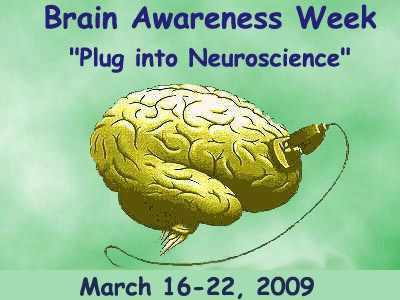
Wishing everyone a healthy new year, one marked by vision, imagination, integrity and insight!
Dr. M. A. Greenstein a.k.a. Dr. G.
The George Greenstein Institute, creating a sustainable future by coaching bodies, brains and minds!
Tags:Bodiesinspace Award, bodiesinspace.com, Body Maps, Brain Awareness Week, Brain Maps, MInd Maps, Neuroplasticity, SpaceSuit Yoga, The New Brain Ecology, Traumatic Brain Injury
Posted in Advances in Neuroscience, Art and the Brain, Body Ecology, Brain Ecology, Brain Training, Meditation, Mental Practice, Mind over Matter, Mind/Brain Training, Mindfulness Practice, neuroleadership, Neuroplasticity, Neuroscience, Somanauts, Somatic, SpaceSuit Yoga, Traumatic Brain Injury, Whole-Brain Neuroscience | 1 Comment »
December 23, 2008
To all somanauts and neuronauts!
The Twitter for the hour: 2008 The Year of the Brain… Wow! What a Year!
We are now reaching the end of 2008 and the Year of the Brain has ushered in some stunning discoveries!
In recent days, the news over the web has taken on great evolutionary proportions: Brains from the Iron Age have survived!: “The oldest surviving human brain in Britain, dating back at least 2000 years to the Iron Age, has been unearthed during excavations on the site of the University of York’s campus expansion at Heslington East.”

I wonder what kind of meditation, exercise or powerbars these guys used to keep their brains alive? (more…)
Tags:Advances in Neuroscience, BDNF and neurogenesis, Evolution of the synapse, exercise and ADD, exercise and addiction, exercise and anti-aging, exercise and neurotransmitters, exercise for the brain, Iron Man's brain, John Ratey, Neuroplasticity, Neuroscience of Attention, Phil George and Surfboards, Qi gong and the brain, Seth Grant, SpaceSuit Yoga, SPARK on brain fitness
Posted in Advances in Neuroscience, Balancing the Brain Hemispheres, Human Physiology, Meditation, Mental Practice, Neural Networks, Neuroplasticity, Somatic, SpaceSuit Yoga, Whole-Brain Neuroscience, Yoga | 6 Comments »
December 7, 2008
The Platform: BBC story: Surfboards Gone Islamic! Work by Phil George
The Twitter: Surf Sufis: InShallah! Ride the Wave to Bliss!
The Big Idea: From Pattern Recognition to Ritual Meditation: Surfing Wires New Neural Maps Using Islamic Art.
I’m excited to share the work of Phil George, my dear Australian compadre whose luscious surfboards have “mapped” the beauty of Islamic meditation imagery on icons of Australian culture. Talk about whole brain, pattern recognition and creating new neural networks by way of visual and moving images!
Check out the following BBC article and video:
BBC: ** Sydney art fuses surf with Islam **
An Australian artist creates a range of Islamic surfboards to create a greater understanding between East and West.
< http://news.bbc.co.uk/go/em/fr/-/2/hi/asia-pacific/7769028.stm >
Video: http://www.youtube.com/watch?v=eGTcMRsJpyI&eurl=http://www.unsw.edu.au/

Phil George, BORDERLANDS, 2008, Casuala Powerhouse Arts Centre
George’s boards capture in one gorgeous icon, the complex histories of art, culture and geo-politics, now the stuff of heated, ugly warfare! In the hands of the artist, ugliness is transformed into a thing of beauty, culture, a thing of dignity and ancient meditation practice …. morphed into a modern ritual of fluid wave motion.
Surf Sufis arise… and may the breath be with you!
Dr. G.
Tags:Arabic Tile Patterns, Art and the Brain, Austalian Surf Culture, BBC AsiaPacific News, Brain Mapping, Casula Powerhouse Arts Centre, Change Your Brain, Islamic Art, Mandala Meditation, Neuro-Aesthetics, Neuroplasticity, Ottoman Tile Patterns, Pattern Recognition and Neural Networking, Persian Decorative Tile Patterns, Phil George, SpaceSuit Yoga Meditation, Sufi Dancing, Surf Sufis, Surfboards gone Islamic
Posted in Advances in Neuroscience, Ancient/Future Technologies of the Body, Brain, Brain Maps, Brain Training, Consciousness, Contemplative Education, Is Beauty Truth, Meditation, Mind/Brain Training, Neuroplasticity, Whole-Brain Neuroscience | 1 Comment »
December 4, 2008
Questions have recently come from readers regarding how to choose a path of meditation? “How do I know which kind is good for me?”
Well dear readers, choosing a meditation (a.k.a. brain fitness practice) is like picking shoes or a favorite climate: It’s a question of fit. And if you’re like moi, the process is going to be a choosy one! By this I mean it takes a careful “buyer’s” attitude to shopping for a method that appeals to your cultural upbringing and sensibility and especially to your neuro-cognitive, emotional, and physical type. Indophiles and Asianists aside, meditation often comes as a package these days, branded with cultural associations that range from ancient jargon to colorful visual motifs!
Still in today’s on and offline markets of meditation clinics, therapies and retreat centers, it’s not so easy for the novice to delineate between Mindfulness, T.M. or Zen, Yoga and Qi Gong. Turning to neuroscience offers some help: Neuroscientists studying human brains before and after specific meditation practices, discover that different methods actually call on different networks and regions within the human brain and… produce different results accordingly!

Artist: Brook, Second Grade, 2004 online image
For example, Richard Davidson and John Kabat Zinn, key researchers in the neuroscience of Mindfulness meditation, published fascinating evidence in 2003, noting measurable and interdependent results in changing both brain waves as well as immune antibodies! (See cited reference below). Theirs is one of many studies that point to the interconnectivity between how we spend our time and where we take our minds!
Translation?: Lower your stress with meditation you accomplish three things: 1) you jumpstart the signaling of positive affect in your brain; 2. You raise your levels of resistance to flu as well! (Think of the money you could save on expensive pharma and drug store cold medicine!) And by the consistent practice, you activate the neuroplastic capacity of the brain to grow itself.
In my life long research and personal study of meditative practices, I find it helpful to ask 3 questions and notice 3 structural types of meditation to order to determine a relevant meditation brand type.
(more…)
Tags:Advances in Neuroscience, Attention Training and Meditation, Breath Meditation, Hatha Yoga, Kundalini Yoga, Meditation, Mindfulness and Immunity, Mindfulness Meditation and the Brain, Moving Meditation, Neuroplasticity, Qi Gong and health improvement, Self Improvement, T.M. Meditation, Yoga and the Brain, Yoga Journal, Zen Meditation
Posted in Advances in Neuroscience, Body, Brain, Breath, Cognitive Science, Meditation, Neuroplasticity, Somatic, SpaceSuit Yoga, Whole-Brain Neuroscience | 3 Comments »
December 1, 2008
For those who have been following the Mumbai Siege and the news on the New York Wal-Mart mob murder, I suspect you are as stunned and horrified by the tragedy and madness of late. These are (sigh)… challenging times.
Yet in today’s edition of The New York Times‘ Week in Review, we read the following: ‘No matter how stressful the conditions, some of us are just genetically inclined towards calm…. or else we learn to manage the neuroticism.’ I’m not sure claims of suffering from high level cortical stress count in a case of neuroticism. Sure, in Jewish and Italian jokes this side of the Pacific, the motif of the suffering mother lends itself to Freudian and Hollywood overtones. But we’re in the age of a paradigm shift, where cultural stereotypes give way to real time strategies that manage the sweaty, messy corporeality of stress: Crying, Screaming, acting out — the drama of human emotion makes it damn near impossible for some of us to calm ourselves down.
One might think this is all a chicken or egg question, but as contemporary neuroscience makes clear, stress–-be it PTSD, sudden shock or chronic stress endured by those in untenable situations–shuts down thinking. Period. The effects can be neurologically devastating: In the U.S., University of California, Irvine researchers have shown that short term stress like long term chronic stress, reduces cellular connections in the hippocampus, the brain region identified with operations of learning and memory. At a time when stress levels are soaring through roofs of homes sliding into default mortgages, we really do need to find a collective way to calm down.
In weighing the options, meditation seems to make a difference, both in reducing stress and in creating some powerful neurological grown patterns. Notable research conducted at mindfulness medical clinics set up at UCLA and at Harvard signifies a movement toward using meditation to mediate stress and poor health. Harvard researcher Sarah Lazar has already shown that Mindfulness Meditation is correlated with a growth of cortical tissue in the frontal cortex and insula (the area said to integrate emotionally relevant, sense perceptions.)

QuBitTechnologies, 2007
I invite readers to peruse this blogsite for how-to’s in stress-reducing, meditative breathing practice, or write in for suggestions of practices that bear relevance to your current situation and learning style.
May the breath be with you.
Dr. G.
Tags:Advances in Neuroscience, changing neurotic habits, Emotional Intelligence, Harvard Mindfulness, Health and Fitness, Insula and sensory perception, Mindfulness Meditation, Neuroscience of Stress, New York Times on the genetics of calm, Sarah Lazar meditation research, Science of Meditation, Self Improvement, SpaceSuit Yoga and the Brain, The Black Friday Wal-Mart Mob, The Brain and Chronic Stress, The Mumbai Siege, UCLA Mindfulness
Posted in Advances in Neuroscience, Body, Brain, Breath, Cognitive Science, Meditation, Mind/Brain Training, Mindfulness Practice, Neuroplasticity, SpaceSuit Yoga | 2 Comments »
November 27, 2008
The Platform: Society for Neuroscience 8 Core Concepts
The Twitter: The Human Brain….it gets curiouser and curiouser!
The Big Idea: Curiosity is the natural province of the human brain!
Of the 8 Core Concepts put forward recently by the Society for Neuroscience, Concepts 7 & 8 may be the most important to drive home, not just to kids and teens but to culture changers and thought leaders of any age: What makes these two concepts so special? Gather for yourself:
7. The human brain endows us with a natural curiousity to understand how the world works. [Notice it doesn’t say why the world works]
8. Fundamental discoveries promote healthy living and treatment of disease.
[http://www.sfn.org/index.cfm?pagename=core_concepts]
For those of you who worship at the temple of the incurious, I guess you can stop reading here. But if you stay with me, I bet it’s because you, like many of us, wish curiosity would come back into style, not in the form of paparazzi gossip feeders but more in the way of thirst that drives explorers, artists and scientists to wander this earth, striving to reach new vistas of insight and understanding. Those of you who saw the recent Werner Herzog film Encounters at the end of the World, will have an idea what I mean. Or check out http://www.stellaraxis.com, a stunning project organized by my dear colleague Lita Albuquerque, who like Herzog, received National Science Foundation grants for art and science expeditions to study the biosphere of Antartica.
By emphasizing curiosity as a given condition of the human brain, SfN sets up the logic for neuroscience itself, that is, to pose questions about the very thing that enables us to be curious, i.e., the brain extended by the nervous system. In a world suffocating with information overload and in a country like the U.S. that has shown venal scepticism towards scientific endeavors, it’s a rare day that we chance to relish scientific achievement. Still, leaders of SfN assure us that neuroscience is that field that will astonish us with “unexpected discoveries that can benefit humanity.”
A colleague recently wrote of neuroscience as perhaps, the single most creative field study within his lifetime. Given my reading and in light of conferences I’ve recently attended, I would have to agree: We are witnessing the rapid emergence of a science that overturns some of the fundamental questions of human physiology, psychology and philosophy while bearing out the truth of others. And with that revolution comes the development of new technologies that allow us to penetrate into the mysteries of Alzheimer’s, Parkinson’s, TBI along with a host of other brain and nervous systems disorders!
Of the many disruptions, one of my favorites is the evidence pointing to the neuroplastic ways in which we ourselves can change our brains and transform stress, injury and unhappiness through daily practice of meditation or focused states of attention.
I will return to these subjects as they are at the heart of my mission in setting up this blog along with a new one that will launch in weeks to come!
Stay tuned and for those in the States, I’d like to dedicate this Thanksgiving holiday to all of the researchers, inventors, intellectuals, artists, coaches and teachers who dare to use their curiosity and encourage others to do so!
Happy Turkey Day! May the Breath Be With You!
Dr. G.
Tags:Advances in Neuroscience, Brain and Curiosity, Curosity as a main value of neuroscience, Encounters at the End of the World, Lita Albuquerque, Meditation and the Brain, Neuroplasticity, Neuroscience Core Concepts, Society for Neuroscience, support for scientific research, Traumatic Brain Injury, Werner Herzog, www.stellaraxis.com
Posted in Advances in Neuroscience, Art and the Brain, Brain, Brain Technologies, Cognitive Science, Meditation, Mindfulness Practice, Neuroplasticity, Whole-Brain Neuroscience | Leave a Comment »
November 26, 2008
The Platform: The Society for Neuroscience: 8 Core Concepts
The Twitter: Hey! Do you know the core concepts of neuroscience?
The Big Idea: Teach 8 core concepts of neuroscience and watch for the tranformation of science and culture at large!
 As previously noted on this blog, The Society for Neuroscience has a noble vision: Identify 8 core neuroscience concepts, teach those concepts (and related principles) to children and teens and imagine a future redefined by a new and inspired league of young brain scientists. “Life should be so good,” as my grandmother use to say.
As previously noted on this blog, The Society for Neuroscience has a noble vision: Identify 8 core neuroscience concepts, teach those concepts (and related principles) to children and teens and imagine a future redefined by a new and inspired league of young brain scientists. “Life should be so good,” as my grandmother use to say.
For neuroscience to compete with the pop wizardry of computer tech, it will take more than mere naming of concepts. I’ll be on the look out for some nifty interactive gizmos and gadgets, the toys and games that drive the concepts home and park them directly in front of the theater of the young mind. Inventors, designers, artists take note!
Since Core Concepts 1, 2, and 3 have been previously noted or inferred in this blog, (for review see below*), I’d like to comment directly on Core Concepts 4, 5, and 6.
Core Concepts 4, 5, and 6 are particularly interesting for those with general interest in brain matters and brain fitness and for those of us who teach or work in creative fields:
4. Life experiences change the nervous system.
5. Life arises as the brain reasons, plans and solves problems.
6. The brain makes it possible to communicate knowledge through language.
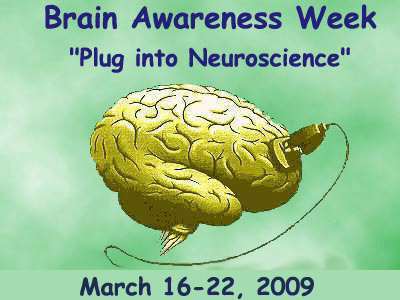
O.K., is it me or do other readers detect the over arching “ratio-empirical” bias to these general concepts? Granted they’ve been conceived by scientists for those studying science. But we’re talking about the whole brain and central nervous system, the brain and spine that keeps our heart and liver pumping, that loves, invents games, pretends, dreams, dances, tells stories in pictures, shares feelings with flowers or with something more gross like dumping garbage in your older brother or boyfriend’s bed! I think what we have here is a conflation of brain and mind, especially, the Enlightenment paradigm for the rational, speaking and writing mind.
Core Concept 5 is a case in point: “Intelligence arise as the brain reasons, plans….” Wait! When did the brain suddenly show itself to be adapted only to analytical practices of difference-detecting leading to logic and planning? What happened to the idea of “multiple intelligence” put forward by Harvard prof. Howard Gardner? What about soma-sensory intelligence? Auditory signals? Visual Icons? Granted, one needs to read further to discover that Concept 5 includes human perception in the process of arising intelligence, e.g.: “senses, emotions, instincts and remembered experience” are counted as being relevant for information processing. Even consciousness gets its due: “Consciousness depends on the normal activity of the brain.” Fair enough, especially if one is learning about traumatic brain injury and coma.
Granted, one needs to read further to discover that Concept 5 includes human perception in the process of arising intelligence, e.g.: “senses, emotions, instincts and remembered experience” are counted as being relevant for information processing. Even consciousness gets its due: “Consciousness depends on the normal activity of the brain.” Fair enough, especially if one is learning about traumatic brain injury and coma.
Yet for those who read deeply into neuroscience literature and into other cultural models of consciousness, remember Gerald Edelman’s argument for the limits of philosophic debate on consciousness. Seems SfN has transgressed the limits and put the question back on the table.
Concept 4 (Life changes the NS): This concept is easier to digest if only due to the increasing press on neuroplasticity. Here we are taught to recognize the interactivity of nature/nurture, to awaken to the role our own lives play in developing nerve cells, to recognize how we affect the health of cells by way of stress and trauma and how we can generate neural growth through our own efforts. A curious notation: “Neuronal death is a natural part of development and aging.” For the anti-aging activists like Aubrey de Grey, this will surely be contested.
And Concept 6? (Communicating knowlege through language) ….What can I say?
Speaking on behalf of the somanauts, artists and designers I’ve taught for over 15 years, I have to wonder where scientists have been during during the culture and cyber wars of the last century? Were they not told of the departmental battles that dared to push “knowledge” and “language” into the larger domains of cultural “meaning” and “sign systems?” Are they simply unaware of pertinent research conducted in fields that stretch from info technology to cultural anthropology?
Allow me then to urge science and all other educators who plan to use the core concepts and who wish to avoid the built in biases, to write to SfN requesting clarification: http:// http://www.sfn.org
Better yet, form study groups and invite a semiotician, a designer, a choreographer, a cultural ethnographer or an intellectual historian — any one who can offer an expanded view of actual brain/mind function in the world!
Finally, I welcome your thoughts and comments and will gladly refer you to texts and topics that unpack these thorny issues. And Look for my comments in days to come on Core Concepts 7 & 8
I remain synaptically yours,
Dr. G. sending breath your way
* Core Concepts 1, 2, 3 (see blogs Nov 17 and 18)
1. The Brain is the body’s most complex organ.
2. Neurons communicate using electrical and chemical signals.
3. Genetically determined circuits are the foundation of the nervous system.
Tags:Anti-Aging and the Brain, Aubrey de Grey, Brain Awareness, Brain Based Semiotics, Brain Education, Brain/Mind debates, Consciousness and the Brain, Dance as a way of knowing, Gardner's Multiple Intelligences, Gerald Edelman on consciousness, Neuroplasticity, Neuroscience 2008, Philosophy of Mind, Society for Neuroscience Core Concepts, spacesuityoga blogs on the brain
Posted in Advances in Neuroscience, Body, Brain, Literature and the Brain, Neuro-Aesthetics, Neuroplasticity, Neuroscience, Somatic, SpaceSuit Yoga, Spinal Cord Mapping, Stroke, Whole-Brain Neuroscience | Leave a Comment »
November 24, 2008
The Platform: Society for Neuroscience: The 8 Core Concepts
The Twitter: Pssst: The brain is the most complex organ in the human body.
The Big Idea: If the brain is the body’s most complex organ, bring on the methods of complexity analysis and think neurotechnology!
The frontier of 21st century neuroscience and neurotechnology can be easily likened to cowboy territory — a rough terrain scoped out by outlaws trying to corner a market while sheriffs attempt to create law and order in the bush!
 In today’s story of the brain, the Society for Neuroscience is that sheriff and the bush of public awareness is as open and dangerous as the wild west! Founded in 1969 and with a new building in Washington D.C, SfN is becoming more and more poised as thought leader, policy maker and leading political advocate for neuroscientists working in the U.S. and abroad.
In today’s story of the brain, the Society for Neuroscience is that sheriff and the bush of public awareness is as open and dangerous as the wild west! Founded in 1969 and with a new building in Washington D.C, SfN is becoming more and more poised as thought leader, policy maker and leading political advocate for neuroscientists working in the U.S. and abroad.
At a time when scientific research in the U.S. has been under attack by ideological religious and political arguments (c.f. Sarah Palin’s infamous fruit fly statement), SfN has picked up the banner of public outreach and set about defining the borders of the neuroscience territory. The first order of business: Establish a set of core concepts and principles for the lay audience, especially for educators teaching science to children and youth at at the K-12 levels (that’s pre-school, primary secondary ed. for our non U.S. readers.)
You can download the concepts at
http://www.sfn.org/index.cfm?pagename=core_concepts
For the neuroleaders, social entrepreneurs and somanauts who follow this blog and for new readers (welcome!), the first concept is worth our attention: [The] Brain is the body’s most complex organ. [my edit]
Please read on….
*******************************************************************
Let’s look at that modifer “most complex.” Think of it: complex, as in tough but not impossible to figure out; complex is in dense, non-linear networks signaling throughout the whole brain, complex as in, ‘gee we need new technology to help us see and recognize the neural patterns that are actually going on in a traumatically injured brain, a dreaming brain, a meditating brain, a brain calculating the high jump or high math!
What I find telling about SfN’s core concepts is this: By naming the brain as complex, researchers open a door to partnering with biotechnologists and systems analysts to update scientific inquiry.
At the ground level, what does this mean for us? What’s the take home message here?
To claim the brain as the most complex organ in the body is to insinuate 4 key points:
First, the brain is not structured as a simple pump and valve system, like the heart or the liver.
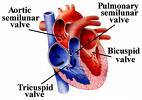
Rather neuroscientists influenced by infotechnology refer to the brain as a machine and liken it to a computer motherboard. This metaphor works at the micro levels of biotech analysis — neurochemistry — modeled off of closed systems.
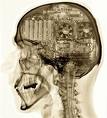
Yet given its neurogenerative and neuroplastic, a.k.a. self-organizing, capabilities, the brain’s own electro-colloidal, anatomical structure begs us to imagine instead, a branching or rhizome system at work. Here we can learn to picture the neuroplastic growth pattern of the brain!
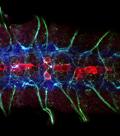
Rhizome image, research conducted by Dr. Torsten Bossing
Second, research and solutions will come to us more slowly than we might desire, unless we invest in the policies and creative approaches of educating our children in brain science and complexity studies.
Third, research and solutions depend upon our enthusiastic support of scientific and creative research into technologies designed to address the tough problems of health and aging that face us in societies throughout the world. Think Star Trek: Resistance is futile. Step into the flow.
Fourth and finally, social entrepreneurs should be on the lookout for new products, new industries and new eco- economic systems that produce, disseminate and control for the wastes stream of products that transform public awareness of brain training from cradle to senior tennis!
Points noted? Welcome to the 21st century, the age of complex problem solving!
Please remember to breath (and sleep)!
Dr. G.
P.S. For a kid’s p.o.v. on brain complexity, check out Dr. Eric Chudler’s terrific site at:
http://faculty.washington.edu/chudler/neurok.html
Tags:Advancing Neuroscience, Biotechnology and the Brain, Brain as complex organ, Brain Science in Schools, Dr. Eric Chudler, K-12 Brain Science, Neuroplasticity, Neuroscience as Cowboy country, Neuroscience for Kids, Neurotechnology a Green Economy, Resistance is Futile, Rhizomes and the Brain, Sarah Palin on Fruit Flies, Social entrepreneurs and the Brain, Society for Neuroscience Core Concepts
Posted in Advances in Neuroscience, Brain, Brain Maps, Brain Technologies, Cognitive Science, Neural Networks, Neuroplasticity, Traumatic Brain Injury, Whole-Brain Neuroscience | 1 Comment »
November 23, 2008
The Platform: Neuroscience 2008: Expanding Brain Awareness
The Twitter: ” I’m aware. Are You?” Brain Awareness Week 2009
The Big Idea: Neuroscience 2108: What will we know? How do we get there?
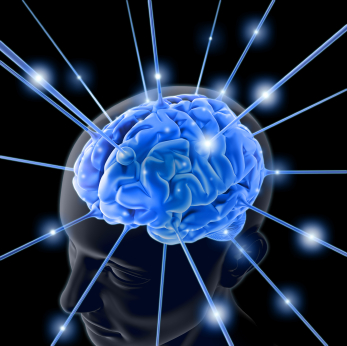
To an audience of young neuroscientists and neuro-leaders gathered to learn more about Brain Awareness Week 2009 (March 16-22), incoming Society for Neuroscience President Professor Thomas Carew reminded the group: ‘Neuroscience research rises out of and gives back to the public good.’
However noble (and ethical) the gesture, it seems there’s nothing cooler than studying the very thing that makes us “human.” And as I’ve tried to show over this last year, there are numerous good reasons why anyone living on Planet Earth in 2008 would want to know how a human brain actually works. More intimate with our bodies than our cell phones, more complicated than our laptops, the human brain begs our curiosity, our devoted attention, our awe! It goes without saying that with an average of 100 billion neurons signaling to each other on any given day, and with the prospect of neuroplasticity programmed into each nerve cell, the brain demands a readied corps of impassioned researchers capable and willing to spend hours, days, months and years observing and decoding the complex and emergent system we call
the nervous system.
The Society of Neuroscience and the Dana Alliance have joined forces to lay the foundational grounds for raising that corps by creating Brain Awareness Week, an international, consciousness raising event devoted to inspiring youth of all ages to learn about the science of the brain. To be frank, I have a lot of faith already in the new grad students entering neuroscience labs. As a generation suckled on the Internet and diagnosed en mass with ADD, they self-admittedly bring to the table, a seasoned sense of video gaming, social networking and a pharmaceutically managed skills of focus and attention. You’ll find them scratching their heads, trying to imagine how their parents ever thought the mind was not connected to the body. With their biotechologically retooled focus on neural networks, these future scientists will map the non-linear circuits of the brain with new neuro-infoschematic programs. Turning to the Allen Spine Atlas to which they will likely contribute, the next generation of neuroscientists will uncover the mysteries of how we regenerate neural tissue, of how we heal and walk again.
With 2009 Brain Awareness Week in mind, SfN leaders announced it will be promoting its 8 “Core Concepts.” In this coming week, I will introduce the core concepts as it relates to the concerns of this blog.
In the meantime, please write to me and ask how you and your friends, your network, your school or your organization can create a knock out Brain Awareness campaign for 2009! (No pun intended!)
With all nerve cells firing!
I remain synaptically yours,
Dr. G. sending breath your way!
For futher info:
The Society of Neuroscience <http://www.sfn.org>
The Dana Alliance <http://www.dana.org/brain.aspx>
Tags:Advances in Neuroscience, Brain Awareness Week, Dana Alliance, Dr. Thomas Carew, Future of Neuro-technology, Neuro-infomatics, Neuroplasticity, Neuroscience for Kids, Society for Neuroscience, The Allen Spine Atlas, Training Neuroscientists
Posted in Advances in Neuroscience, Body, Brain, Cognitive Science, Consciousness, EEG & Consciousness, Neural Networks, Neuroplasticity, Spinal Cord Injury, Spinal Cord Mapping, Traumatic Brain Injury, Whole-Brain Neuroscience | Leave a Comment »
November 18, 2008
The Twitter: Nurture your Nature!
The Big Idea: Neuro-Plasticity is critical to neurogenesis (But when and how?)
Allow me to start with a question: How many of you really believe that “exercise” can change your brain? How many of you have already adapted yourselves to a non-fast food diet of low fat, low sugar, low volume eating lifestyle? And how many of you take a nap to replenish memory of all those nifty concepts and technical skills you learned in the early a.m.?
Well if you were a fly on the wall in any of the Neuroscience 2008 sessions (rather than submitted to a lab of brain probe research!), you would detect a consistent pattern in neuroscience research: Nature and Nurture are inextricably linked — so much so as to push us to think why did we ever think otherwise? Or to put it another way, news from the brain labs reinforces what we’ve learned from cardiac research and training grounds, namely: Lifestyle can make or break one’s future in obtaining a clear mind and good and healthy longevity!
Having the opportunity to meet and listen to neuroscientists who are paving the way to our understanding of both the normal and diseased brain and body has pointed up to some insights worth sharing:
1. Scaling the practice of Brain Mapping: When it comes to neuroscience as a research area of biotechnology, the bio here means both neuroanatomical, neurochemical and neurogenetic levels of inquiry and analysis. For the lay reader, this means brain research is scaled and mapped from the macro to the micro levels of network analysis.
2. Neuro-Plasticity, like comedy is all about timing! Different levels of circuit analysis open doors to understanding the phenomenon of neuro-plasticity — best periods, best practices, and the conditions when “too much plasticity” appears implicated as in cases of schizophrenia. Given the trendiness that has brought neuro-plasticity into critical mass awareness, scientists at this conference were quite clear if not humble in making claims for the play-doh capacity of the brain. Today’s press conference on the developing brain drove home this message in this way:
Animal studies, such as the songbird studies run by Dr. Allison Doupe (see previous blog), point to a critical period for neuro-plasticity to express itself in learning and memory.
Dr. Takao Hench* reinforces Doupe’s perspective, noting if the critical period is disturbed in embryonic development, then plasticity is interrupted. Hench studies proteins in embryonic head development, finding their importance in developing visual function and spinal chord development.
No doubt, the evidence for embryonic and childhood neuro-plasticity opens new doors to asking how and when new neuronal landscapes are formed in later periods of life. The aging brain question on the table? Does the brain recapitulate earlier strategies for neuroplasticity in the adult stage and to what degree? (All you meditators out there: Think cultivating beginner’s mind.)
3. Nurture your Nature: With the advent of genetics, neuroscience has leaped into a new age of epigenetic studies: This may be one of the areas that speaks directly to how we as non-scientists can make sense of brain science in terms of our own daily lives. To give you a quick brief, think of the old nature/nurture argument, seemingly put to rest by the genome mapping project and the insights scientists have had regarding the role “environment” plays in shaping the genetic expression.
At Neuroscience 2008, several scientists were on hand to discuss their epigenetic research highlighting the effects of lifestyle and cultural habit on the brain as seen at the level of genetic expression. Let’s be clear here, the expression is not seen at the level of change in DNA structure but in the level of “gene expression.” For you genomic neophytes out there, I came to understand this by way of a great explanation offered by Dr. Quincy LaPlant who noted his use of microray analysis to distinguish between DNA sequence and sequence organization.
The long and short of this: The implications of lifestyle cannot be under-estimated: Stress, early childhood abuse and neglect, high-fat diets all manifest as modifers the brain at the level of genetic organization, the level of brain function, and the level of human experience!!!!!
Epigenetics — keep your eye on that term!
More tomorrow….
Until then, conference tip for brain fitness: “We remember to sleep so that we can sleep to remember!” (William Fishbein)
*Children’s Hospital Boston, Harvard University
Tags:Adult Neuroplasticity, Allison Doupe, Childhood Neuroplasticity, Critical periods for Neuroplasticity, Epigenetics and the Brain, Fly research in science, Growing Neuronal Landscape, Human Genome Project, Lifestyles for the Brain, Nature vs Nurture, Neuroplasticity, Neuroscience 2008, Neuroscience of Learning, Takao Hench, The effects of child abuse on the brain
Posted in Advances in Neuroscience, Biotech, Brain, Neuroplasticity, Neuroscience, Spinal Cord Injury, Traumatic Brain Injury, Whole-Brain Neuroscience | Leave a Comment »
November 17, 2008
A quick post during a simulated lunch break:
What’s hot at Neuroscience 2008? Sex, Drugs and Rock n’ Roll.
Let’s decode the ’60’s motif in terms of 21st century interests:
Sex: Neuroscientists are busy looking at neuropeptides and their effects on mating and long term animal bonding and attachment practices. It seems oxytocin and vasopressin release in small animals (voles) point up to “social” practices of trust and the sticky principle of alliance! Monogamy seems to trump extra “marital” wandering at the neurochemical level of animal behavior!

Voles in Love! Illustration by Dugland Stermer for TIME 2008
Drugs: In light of the toll drug abuse takes on human life and society, neuroscientists are conducting a large array of cortical studies that show the epigenetic and neurochemical factors that show up in drug addiction. There have been some pretty fascinating presentations, noting the “circuitry” of addiction cycles in mice and rats in administered and self-administered rodent trials. The drug of choice: Cocaine…. Food for thought: Jane Taylor of Yale mentioned a comparative study of cortical damage shown in cases of drug addiction and in cases of brain lesions.
Rock n’ Roll: The coupling of genetics and neurochemistry is producing new understandings of factors contributing to loss of motor control and imbalance. Of the several diseases that affect sensori – motor circuitry, Parkinson’s Disease has figured strongly in this conference, highlighted best by the conference organizers bringing in choreographer Mark Morris to teach neuroscientists about his movement classes for Parkinson’s patients! For the somanauts reading this blog, it’s worth noting as well, a presentation by Dr. Kadivar at Louisiana State U, noting the success of theraputic intervention in Parkinson’s patients through the use of auditory, rhythmic beats to stimulate patient walking!
Given the slow, arduous nature of scientific studies and rigor with which the outcome of studies is handled in the public sphere, it’s clear that in the vast universe of brain and central nervous system exploration, certain topics of study push the hot button of funding interests and social concerns. Joining bonding, addiction and disturbed sensor motor control in the 2008 topics list, one finds Autism, Traumatic Brain Injury, Neuroplasticity (in the Sensory and Prefrontal Cortex), and of course, the technologies that advance and afford the imaging and computation of norms and disturbances in all brain functions, namely the frontier fields of Neuroinfomatics.
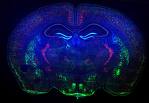
With an eye on the technologies that afford us new possibilities of inquiry of time/space correlates in brain function, I’m happy to report there have been focused sessions on neuroinfomatics and neurotechnology — including new schematic imaging projects like the Brain Navigator project produced by Elsevier (a publishing group based in Amsterdam) in partnership with the Seattle based Allen Institute for Brain Science — the same center whose spinal cord atlas project was previously mentioned on this site.
The take home message: New and Better Maps show more of the territory!
Synaptically yours!
Dr. G.
Tags:Allen Institute for Brain Science, Bonding studies, Brain Atlas, Brain Navigator, Drug Addiction and the Brain, Elsevier and the brain, Mating practices, Neuroinfomatics, Neuroscience of Love, Schematics of the brain, Technology and the brain, Therapies for Parkinson's Disease, Trust and the social brain
Posted in Advances in Neuroscience, Body, Brain, Cognitive Science, Neuroplasticity, Neuroscience, Spinal Cord Mapping, Traumatic Brain Injury | Leave a Comment »
November 17, 2008
The Platform: Neuroscience 2008, Washington D.C., Convention Center, Day 2
The Twitter: Systems analysis comes to Neuroscience!
The Big Idea: Brain Maps and Brain Circuits Open the Doors to Studies in Neuroplasticity!
If there is a primary metaphor, a picture which best communicates the paradigm shift in neuroscience, it is the image of “mapping.” Makes sense, right? Maps, as we all know, hail back to some of the earliest days of navigational science, when cartography was as much a visual art as an artifact of empirical science.

Today, mapping along with circuits, networks, and other info-tech terms have entered the lexicon of neuroscientific thinking — and to that end, has in part redefined how neuroscientists study the neurogenetic and neurochemical operations of the brain. No doubt, the cyberpunks and digerati reading this blog do so in complete and utter wonder. Yes, it seems a collective head scratching is in order when putting the neuroscience paradigm shift in context to the cybernetic revolution named nearly sixty or so years prior. Then again, as historian Thomas Kuhn reminds us, glacial is the speed of great scientific revolutions.
 Surveying the mob scene at Neuroscience 2008 and listening to some of the symposia lectures, I suspect the shift has come with a generation of researchers who grew up on Atari and first generation X Boxes, who have played with “code” on Second Life, or who have picked up a thing or two from grad students who majored in 3-D modeling before they decided to switch to neuroscience. It might also be the case that the cognitive systems science work of Maturana and Varela, the Neural Darwinist writings of Gerald Edelman and new biotech imaging tools have made their way into labs throughout the world. These are questions I will pose to the scientists and doctoral students during the next two days.
Surveying the mob scene at Neuroscience 2008 and listening to some of the symposia lectures, I suspect the shift has come with a generation of researchers who grew up on Atari and first generation X Boxes, who have played with “code” on Second Life, or who have picked up a thing or two from grad students who majored in 3-D modeling before they decided to switch to neuroscience. It might also be the case that the cognitive systems science work of Maturana and Varela, the Neural Darwinist writings of Gerald Edelman and new biotech imaging tools have made their way into labs throughout the world. These are questions I will pose to the scientists and doctoral students during the next two days.
In the meantime, under the clear, shining light of brain circuit mapping, “epigenetics” and “neuroplasticity” have taken center stage in neurodevelopmental and neurochemical studies. There were some like Zack Lynch of NIO* who questioned a round table discussion of NIH directors regarding the future of government funding to these studies. Dr. Nora Volkow of the NIH Drug Abuse program was one who offered a particularly optimistic view stating, ‘Epigenetic evidence opens the doors to future studies in neuroplasticity’ — studies that can unlock the mysteries of how human experience actually modifies and shapes the genetic markers of brain development.
Yes, gang, it’s “the brain creates culture, culture creates the brain” argument rethought in neurogenetic and neurochemical terms. Seems we are back to talking about nature/nature once more.
I leave with one thought on brain mapping, rethinking the words of American philosopher Josiah Royce who is quoted as saying, “The map is not the territory.”
Well, at Neuroscience 2008, the map is the territory, at least for now.
From D.C. this is Dr. G, wish you good neural networking!
*Neurotechnology Industry Organization
Tags:Autopoeitic Systems, Bodies in Space and the Brain, Bodiesinspace at Neuroscience 2008, Brain Circuits, Brain Mapping, Epigenetics, Gerald Edelman and brain mapping, Imaging the Brain, Maturana and Varela, Neural Networks, Neuroplasticity, Neuroscience 2008, NIH Drug Abuse Program, paradigm shifts in science, Society for Neuroscience, SpaceSuit Yoga and the Brain, Zack Lynch and NIO
Posted in Advances in Neuroscience, Brain, Brain Technologies, Cognitive Science, Neuroplasticity, Neuroscience, Self-assembly, SpaceSuit Yoga, Spinal Cord Mapping, Whole-Brain Neuroscience | Leave a Comment »
November 16, 2008
The Platform: NEUROSCIENCE 2008, Convention Center, Washington D.C.
The Twitter: How many neuroscientists does it take to put in a light bulb?
The Big Idea: The future of neuroscience lays in the hands of youth.
Intense? Immersive? An Indeterminate Neural Network? Making it through a crowd of over 30,000 people, and a four day roster that includes symposia, mini symposia, keynote lectures, satellite events and over a 1000 poster and slides sessions, does, as one AI scientist once remarked, separate the human from the robot.
And it is that extraordinary navigational capacity of human intelligence and specifically, the human brain, along with a whole host of questions about the brain that has drawn neuroscientists young and old to the rainy U.S. capital, to share their research, update their brains and discuss the future of advocating brain awareness at NEUROSCIENCE 2008!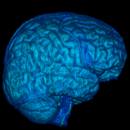
With neuroscience becoming the seductive frontier of 21st century biological, medical and cognitive science study, as well as the field of promising and lucrative applied biotechnologies, NEUROSCIENCE 2008 is the brain child of the Society for Neuroscience, a dedicated group of scientists that has grown in membership and in sensibility regarding the role they play in developing allied research, public policy and K-12 education where the brain is concerned.
For the lay public, the hard science description of pain-staking empirical studies is enough to send the unitiated back to talking about Leggos, Pac-Man and 7th grade science fair. Yet as inimitable choreographer Mark Morris was apt to point out to the audience during the opening Keynote discussion, “the problem of talking about what’s going on in the brain, is not mine but yours!”
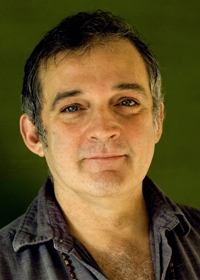
Mark Morris
It was rather confirming for yours truly, to find the president of SFN, who researches rhythm, choosing the once bad boy post modern choreographer to open the annual meeting. The brain is, after all, in a body, and from the sessions I attended today, it seems more and more scientists are reading to point to roles experiment and experience play in shaping neural growth and visa versa. And yet, the questions put to Morris suggest that scientists might want to do more dancing or as Morris reminded them, “more skipping,” if they want to study the choreographic corellates in the somasensory cortex. Morris, a performing artist known for his love and sensitivity to the musicality of dancing, and now for his work with Parkinson’s disease, drove home the message of using somatic intelligence: ‘It’s not something that abstact, like thinking, “now this left foot, on this second beat.” It’s more like: “Here… Now.”‘
I must admit, the rudimentary science questions put to Morris pointed up to the old C.P. Snow two culture divide, pitting science and art against each other like political foes. I for one, was rather shocked by the retro p.o.v. pervading much of the scientific thinking, signaling a real gap in the education of scientists regarding the “research” conducted by somanauts like performing artists and athletes. Then again, Morris, the uber cosmopolitan, had no better understanding of the science of brain/mind/body connectivity. Sigh.
 The afternoon Presidential lecture given by Dr. Allison Doupe offered a different picture of art and science. Doupe gave an exquisite talk on the pattern recognition capacities of songbirds, and posed the question: ‘What can we can we learn about neural basis of “vocal” practices as distinct from performances? How does the nervous system mediate behavior?’
The afternoon Presidential lecture given by Dr. Allison Doupe offered a different picture of art and science. Doupe gave an exquisite talk on the pattern recognition capacities of songbirds, and posed the question: ‘What can we can we learn about neural basis of “vocal” practices as distinct from performances? How does the nervous system mediate behavior?’
A terrific speaker, poised and passionate, Doupe’s research pointed to several neural circuits that appear to operate in directing the process of learning a new pattern of sound, practicing the new pattern, and performing it to accomplish a “salient” goal, in the case of songbirds, a male finch courting a female.
My favorite Doupe image? The one that showed how courting performance showed little randomness in pattern generation! The take home message? Forget the creativity bud. If ya want the girl, just sing the damn song!
Leaving some of us to ponder the implications of romantic innovation, Doupe’s lecture did reinforce one of the key ideas and metaphors, surfacing in the language of neuroscientists presenting at this conference: the role of pattern recognition and neural mapping in development and learning.
More tomorrow!
Synaptically yours,
Dr. G.
Tags:Allison Doupe, Brain Awareness, Dance and the Brain, Dancing and Knowing, Human vs Robot Intelligence, Mark Morris, Mark Morris & Parkinson's Disease, Neuroscience 2008, Society for Neuroscience, Somatic Intelligence, Song Bird Courting Behavior, SpaceSuit Yoga and the Brain
Posted in Advances in Neuroscience, Art and the Brain, Brain, Cognitive Science, Neural Networks, Neuroplasticity, Somatic, Uncategorized | Leave a Comment »
November 13, 2008
Greeting Somanauts!
I’m off to Neuroscience 2008 where I will spend 4 days with ear and brain to the ground, wall and any other surface that is vibrating with news from the international neuroscience research field! Thirty thousand scientists, neuronauts and neuroleaders are expected — that’s right, nearly 30,000 brains that have devoted hours of “attention density” to the frontier of neuroscience and neuroscience education. Talk about wattage!!!!
Due to an “embargo” placed on writing before the official press conferences, I will start posting formal review starting Sept 18.
However, do look for my tweeters now and then.
Speaking of attention density, other news: SpaceSuit Yoga Advocates the MindBody Project:
With Obama speaking directly to our broken health care system, BrainMindBody health advocacy groups are organizing to create an ‘Educate Obama‘ campaign.
Please Join me and others to inform our visionary President Elect and his transition team on the remarkable research in NeuroSomatic Health Practices, namely, the empirical research and education projects in brain/mind/body integration that point to the interrelation of
increasing stress and rising health costs.
and
decreasing stress and lowering of health costs.
Below are two links for joining the effort of a media campaign to awaken our new American leaders to the benefits of preventative medicine: This from a letter sent by http://www.worldtaichiday.org/
To Obama and Team:
The Obama Transition Team Site’s Contact Page is: http://change.gov/page/s/contact
A sample intro:
WHY IS STRESS AN INCREASING PROBLEM?
Bill Joy, the Chief Scientist of Sun Microsystems estimates that the speed of change is doubling exponentially every 18 months, and the speed of change will only increase in coming months, years, and decades. Change is stressful, even good change.
The change we have faced is daunting, but nothing compared to the next generation’s challenges of managing the stress of accelerating change.
It is in our interest to provide stress management achieving mind/body tools to adults, but particularly to the new generation(s), because their accumulating unmanaged stress of today, will translate into trillions of dollars of health costs in years to come.
To Incoming Medical and Education Officials:
Go to the web page below and print out 3 copies of the form letter. Send a postal mail to the incoming Secretary of Health, the Secretary of Education, and the incoming Surgeon General, to arrive on their desk when they take office on January 20th.
http://www.worldtaichiday.org and follow the links to MEDICAL RESEARCH and EDUCATION PROJECTS!
As always, may the breath be with you!
Synaptically yours,
Dr. G.
Tags:Meditation for Preventing Stroke, Neuroplasticity, Neuroscience 2008, neuroscience research, neurosomatics, Obama's health plan, Preventative Medicine, Reduce Health Costs, Society for Neuroscience, somatic healing, SpaceSuit Yoga Advocates MindBody Project, Stress Reduction, World Tai Chi and Qi Gong Day
Posted in Advances in Neuroscience, Brain Technologies, Breath, Contemplative Education, Human Physiology, Meditation, Mind/Brain Training, Mindfulness Practice, Neuroplasticity, Restorative Breath Protocols, Somatic, Theory of Everything, Uncategorized, Whole-Brain Neuroscience, Yoga | Leave a Comment »
November 5, 2008
NeuroLeadership!!
I pose this comparative think as today, a very special day in the U.S., when we pick our nation’s leader to take us forward into this new century, I look back over the last year’s responses to SpaceSuit Yoga.com and marvel at the interest that Michael Phelps and Dr. Jill Bolte Taylor have stirred within the online community! In light of the press and audience commentary that covers these two American heroes, I have no problem nominating both Phelps and Dr. Taylor as role models for neuro-leadership.
That’s right, if one takes the premise and profile of neuro-leadership put forward in recent NY and Sydney NeuroLeadership Summits (and as reported on this website), both Phelps and Dr. Taylor model the behavior of one who achieves success by way of brain-based approaches to problem solving, especially in two ways:
1) the rigorous, consistent use of attention to problem-solving by means of task-oriented solutions;
2) the generous offering of themselves as motivational coaches in the service of others.
 In the case of Phelps’s winning 8 gold Olympic medals, we witnessed en mass, the results of his paying close attention to all that is required of a star Olympic swimmer, namely,
In the case of Phelps’s winning 8 gold Olympic medals, we witnessed en mass, the results of his paying close attention to all that is required of a star Olympic swimmer, namely,
a) consistent refinement and improvement of his strokes by invoking attention to spatio-temporal agility,
b) highly motivated, goal focused projection of his human energy, and
c) a keen and consistent application of attention to all that it takes to fuel a body to move in pool water like a great Mako shark!
 In the case of Dr. Taylor, who suffered and survived quite nicely, a severe stroke in her left hemisphere, we learn the key lesson through her various online and offline modes of presentation (all previously mentioned on this blog): Regaining access to speech and to Prefrontal Cortex executive functions (analysis, judgment, decision-making) required a kind of Olympic style commitment to “paying attention” to re-learning vowels and consonants, to being able to conceptually distinguish and label right from left.
In the case of Dr. Taylor, who suffered and survived quite nicely, a severe stroke in her left hemisphere, we learn the key lesson through her various online and offline modes of presentation (all previously mentioned on this blog): Regaining access to speech and to Prefrontal Cortex executive functions (analysis, judgment, decision-making) required a kind of Olympic style commitment to “paying attention” to re-learning vowels and consonants, to being able to conceptually distinguish and label right from left.
As Jeffrey Schwartz outlined clearly on the first night of the NeuroLeadership Summit and again throughout the whole of the summit proceedings, “attention density” is that key to changing the brain and thus the very conditions and propensities if you will, of our individual body/mind. And as David Rock was apt to point out, if attention is the protagonist in our mental theater, insight is that beautiful arc we reach as we crystallize evanscent images and thoughts.
The story of Phelp’s prep for Olympic spectacle, the drama of Taylor’s enlightenment — each make for a powerful tutorial on leadership development in training. As for generosity in the service of others, it is clear by their mutual willingness to take their insights and transform them into tools for educating and possibly saving the lives of others, Michael Phelps and Jill Bolte Taylor visualize for all of us the continuum of human excellence in learning and performance.
My SpaceSuit Yoga questions to you dear somanauts, are this:
First, “If you could learn anything about the human brain, about your own human brain, what would you like to know and what would you do with that information?”
Second, “How do you practice “paying attention?”
I welcome your responses and comments. And please know that in the coming months, my institute will be offering special “attention and awareness” training sessions for private individuals and those developing leadership.
As always, May the Breath Be With You!
Synaptically yours,
Dr. G.
P.S. At the time of writing this, it appears Barack Obama has been named President-Elect of the U.S.A.! Talk about attention density and generosity in the service of others!
Tags:Attention Density, David Rock on insight, GGI Attention and Awareness Training, Jeffrey Schwartz on attention density, Jill Bolte Taylor, Michael Phelps, NeuroLeadership Summit 2008 NY, Neuroplasticity, Neuroscience, Olympic Sports Training, Recovery from Stroke, SpaceSuit Yoga, Traumatic Brain Injury
Posted in Advances in Neuroscience, Body, Brain, Consciousness, Contemplative Education, Jill Bolte Taylor, Mental Practice, Mind over Matter, Mind/Brain Training, Mindfulness Practice, Neuroplasticity, Traumatic Brain Injury | 3 Comments »
October 29, 2008
The Platform: NeuroLeadership Summit 2008, Day 1
The Twitter: Psssttt! It’s all connected — brain, body and mind!
The Big Idea: Rethinking leadership from an interdependent whole-brain, whole-body, whole-mind networked point of view!
David Rock, founder of the NeuroLeadership Institute and organizer of both the NY and Sydney meetings this year, noted last evening that today’s most urgent issue, as seen by companies and businesses across the global sphere, is the crisis of developing leadership. With that in mind, Rock invited world-class scientists to give keynote talks — presentations which should help this year’s summit partipants picture a new paradigm of “best practices” when approaching the question of developing leadership.
For yours truly, it was a deep and gratifying pleasure to be immersed in an arena wherein scientists, coaches and consultants seriously broached the topic of new neuroscience and the myriad of ways to connect body, mind and brain in human learning, performance and innovation, be it at home, school, in sport or in the workplace.
Again, time is limited to tell all (more will be fleshed out post summit) but here’s the beef on today’s keynote talks — which by the way, are followed up by generous amounts of time for question and break-out focus group discussions:
From the first keynote by Dr. Amy Arnstein to the last one of the day delivered by Dr. Kevin Ochsner, the frame for Day 1 stretched across a psychological continuum: Arnstein cogently tackled the neurochemical correlates to interrupted moments of perception and cognition (either by way of daily stress or by profound mental illness); Ochsner closed the long intense day by chunking the complex study of human emotion into a bite size expose on the neuroanatomical correlates to strategies that effect emotional experience and behavior, e.g. “reappraisal” of emotional narrative. (Arnstein gets two thumbs up for a spiffy visual presentations. As one researcher noted — the cartooned versions of neurotransmitting processes signaled well with ‘low noise’ residual.)
With the frame set by these two talks, were some real nuggets of 21st century thinking — the sort that reinforces the hard work reseachers, thought leaders and cultural changers have put forth for more than half a century in communicating
1) the value of “insight” in innovation and
2) “mindfulness” (or meditation) experiences in modifying how we use our “attention” in goal directed tasks.
Within the break out discussions, some facinating and tough questions were raised by the audience regarding cross-cultural imprinting and bias in charting the neuroscience of perception, leaving a door open to comparative cultural studies, especially with developing leaders in the global sphere is concerned.
While all of the keynotes were delivered in impeccable style, Dr. Yi-Yuan Tang’s lunchtime presentation clearly touched my brain and heart in his clear and playful deconstruction of cultural definitions of “mindfulness” experience to make room for the semantics of a neuroscientifically informed picture of brain/mind/body operations and connections that enter into the “mindfulness state.” As one who first came to mindfulness through the Martial arts, Yuan placed before us the challenge of knowing how to engage attention and awareness in a way that helps us “integrate” body/mind and brain in the experience of “being” (as to be distinguished neurologically from “thinking or doing.”) In response to Tang’s talk, David Rock offered a tip he found helpful in his study of mindfulness, namely the strategy of distingushing between narration (interpretation) and direct experience — each having their own correlates in brain anatomy and brain chemistry.
As I have noted on this blog, the brain/body/mind connection is one we can’t emphasize enough. It speaks of a new way to recognize our very humanness as a function of emergent networked processes, allowing us to integrate in a multi-dimensional fashion, a host of relations between what and how we think/feel and do.
The message from today’s proceedings: The responsibility of developing effective and even inspiring 21st century leadership rests on the shoulders of the somatically and neuroscientifically aware.
One can find the summit proceedings schedule on the NeuroLeadership.org website.
More manana.
Syaptically yours,
Dr. G.
P.S. A self-referential historical note regarding the inception of the blogsite: I wrote my dissertation in the late ’80’s on “attention and awareness training” practices used by American performing artists. Sometimes a good idea like cheese, needs time to age. Please write if you have questions about the literature on attention training.
Tags:Amy Arnsten on brain chemistry, Brain Based Coaching, Brain/Mind/Body Training, Business and the Brain, Consciousness and Attention, Crisis in Leadership, David Rock on mindfulness and leadership, Improving Human Performance, Improving Leadership, Insight and the Brain, Kevin Ochsner on emotion, Mindfulness Meditation, Neuroanatomy of Emotion, Neurochemistry of Stress, Neuroscience Summit 2008, SpaceSuit Yoga and Neuroscience, The neuroscience of attention, The Neuroscience of Cultural Determinants, The Neuroscience of Leadership, The Neuroscience of Meditation, The psychology of attention, Whole Brain/Whole Body Integration, YiYuan Tang on mindfulness
Posted in Advances in Neuroscience, Body, Brain, Meditation, Mindfulness Practice, Neuroplasticity, Neuroscience, Right/Left Brain | 1 Comment »
October 29, 2008
The Platform: NeuroLeadership Summit 2008: Opening Keynote Address
The Twitter: WOW!!!!!!Quantum Mechanics Dates Neuroscience and finds an attractive mate!!!!!!
The Big Idea: Attention Changes the Brain as understood from the standpoint of Quantum Mechanics….
Yawzaa! Talk about brain training for neuro-leaders at the quantum level!!!! The first night of the NeuroLeadership Summit 2008 in New York City has blown everyone’s mind with a turbo charged presentation by Jeffrey Schwartz, M.D., UCLA and his mentor, the visionary Quantum Physicist and Author Henry Stapp. Schwartz, who appears to nearly jump out of his skin with enthusiasm when speaking, uses baseball metaphors for delivering “fast balls” on the question of “attention” in Q.M. Schwartz’s key point? Bringing neuroscience and Q.M. together in a unified field theory over-rides the inadequacies of Newtonian physics in coming up with plausible mathematical formula and explanation has to how we can observe and understand, with reasonable veracity, the movement of large bodies, like the human body.
The nearly two-hour presentation called for a deep deep think on the part of this observer and begs for a gorgeous visual map to point to the multiple vectors of interrelated ideas. Forgive me then, in this brief period of online time to outline the team’s main points concerning a new way to discuss neuroplasticity to an audience focused on the question of leadership, be it in business, education, government or related areas of human learning and enterprise:
1. The Marriage of Quantum Mechanics with Neuroscience: The marriage challenges the Newtonian model of physics, which leaves out the role of the observing agent, the agent that poses questions about the phenomenal world. In the Newtonian model, there is a purposeful blindness imposed upon the role the observer and his or her tools of observation play in influencing the inquiry and observation… hence, the Newtonian science of refutation and double-blind experiments.
2. The Role of Interactivity between the Observer and the Observed: The Neuro-Q.M. theory takes off the self-imposed empirical blinders and moves the question of information gathering and observation to address the interactive aspect of inquiry and observation. In this model, interactivity between “the observer and the observed” helps to create the potential answer to the question posed. Sound familiar, somanauts?
3. Invoking Attention Density and the Executive Action Template create the conditions for interactivity of the observer with the observed.
Definitions first:
What is Attention Density? Distinct from “concentration,” attention density involves repetition of attention, as in learning a new skill, like learning to swim, learning to read, learning to eat only one piece of chocolate, or even learning to recover from a stroke!
What is the Executive Action Template: This term refers to the executive functions — analytic difference detecting, syllogistic reasoning and decision making — correlated with activity in the Pre Frontal Cortex of the human brain.
Schwartz and Stapp argue for the role of the “impartial observer” — the observer who uses “attention” — and this is important — specifically, the repetition of attention plus the engagement of intentional executive action to pose questions in an interactive fashion with the phenomenal world and thus discover/create a possible answer to the questions posed.
In other words, for Schwartz and Stapp claim Attention Density and Executive Action are said to be the two determining factors in creating the conditions for the impartial observer and the conditions for the moment probability collapses into a unit of possibilty or “an answer.” Now there is a complex Q.M. theory of how this actually works and I’ll leave it to you dear readers to start doing your own interactive search to learn about the necessary correlation between “attention density” and the “collapse function” in Q.M.
The implications for Neuro Leaders? Schwartz and Stapp point to a radical and “rational” rethinking of leadership and organizational systems models by suggesting:
1) The lessons of neuroplasticity: One can now acknowledge the fact of neuroplasticity — the brain creates the mind and the mind creates the brain — and how it is generated and conditioned by asking questions, by being curious, by the act of paying repeated attention, by making inquiry, by learning and sharing information;
2) Bottom Up Flow of Information: By recognizing the Neuro-Q.M. theory of probability, one can begin to value bottom up information flow. Workers are not mindless cogs in a machine but rather brain/mind attentive information “workers.” (To better understand the bottom up theory of info flow, check out Steven Johnson’s EMERGENCE: a great study for neuro leaders who wish to take lessons from developing ant colonies, developing cities, developing brains and open systems software practices!)
3) Neuro leadership is hall-marked by invoking a brain based/quantum understanding of the role of attention, interactivity and decision-making in all aspects of human performance. The Schwartz/Stapp model encourages us to take seriously the interactive possibilities of the brain in relation to the interactive possibilities posed by the use of our other research tools, be it a gene splicer, a sub-atomic particle accelerator.
There is so much more to say but time is running out. Let it be noted that the ghost of dualism clearly plagued the presentation as did the mechanistic semantics of Newtonian physics, e.g., Stapp referring to humans as machines.
‘Oi Vey.’ I will take that one on in another blog.
More tomorrow. Until then, attentive breath be with you!
Dr. G.
Tags:Attention Density, Brain Creates Mind, Executive Decision Making and the Brain, Henry Stapp, Jeffrey Schwartz, Mind Creates Brain, Neuro Leadership Summit 2008 NY, Neuroplasticity, Neuroscience of Attention, Neuroscience of Business, Neuroscience of Leadership, Neuroscience of Learning, Physics meets Neuroscience, Quantum Mechanics, SpaceSuit Yoga and Neuro Leadership, The George Greenstein Institute, The Impartial Observer and Brain Science
Posted in Advances in Neuroscience, Body, Brain, Brain Training, CERN, Consciousness, Cosmic Wonder, Mind over Matter, Mind/Brain Training, Mindfulness Practice, Neuroplasticity, Quantum Mechanics | 2 Comments »
October 27, 2008
Dear readers,
News on the home front;
First, commentary continues to flow from Dr. Jill Bolte Taylor’s talk on Oprah. A neuro-leader if there ever was one. Please enjoy the discussion that ensued on this site.
One of the questions to arise: Should we be devoting our lives to training our brains for bliss, or should bliss pursuits be relegated to the cloistered arena of mystical experience? Of course, the dualist framing of the question is unfortunate for as Taylor herself points out, right-brain enhanced joy is not licenced or owned by religious seekers. Think of the pattern recognition operations that go on in the mind of painters or fabric designers?
For those interested in a critical, psychological analysis of American mystical experience, try starting with a standard and truly royal read: William James’ VARIETIES OF RELIGIOUS EXPERIENCE. James, the father of American psychology and a spacious thinker on the question of brain-mind relations, takes one on a tour of the diversity of American religiosity. Seems we in the U.S., have not strayed too much from our turn of the century predecessors.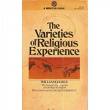 As James is one of my favorite American thinkers, I can’t help but think he would be totally turned on by the big movements in neuroscience and neuro-education — the sort Taylor insinuates in using neuro-anatomy to tell her deeply personal story of survival and transformation! I only wish James were alive today to join me at the upcoming 2008 Neuroleadership Summit in NY. I will be blogging on the event — and upon my return will be offering my services to those looking for consultants to design and set up neuroleadership and neuro-fitness programs in their companies and institutions
As James is one of my favorite American thinkers, I can’t help but think he would be totally turned on by the big movements in neuroscience and neuro-education — the sort Taylor insinuates in using neuro-anatomy to tell her deeply personal story of survival and transformation! I only wish James were alive today to join me at the upcoming 2008 Neuroleadership Summit in NY. I will be blogging on the event — and upon my return will be offering my services to those looking for consultants to design and set up neuroleadership and neuro-fitness programs in their companies and institutions
In the meantime: to embolden your own neuro-leadership program, try and practice a few of the basic “brain tips” mentioned on this site:
Mid-day napping
Bringing breath awareness to your athletic or other human performance training
Spinal rolls: juicing up the joints of the spine for greater blood and chi flow!
And a new one to be discussed in future blogs: Think Popeye and eat your spinach!
May the Breath Be With You!
Dr. G.
Tags:Brain and God, Jill Bolte Taylor, Jill Bolte Taylor at TED, Jill Bolte Taylor on Oprah, Mystical Experience and the Brain, Neuro-Leadership, Neuroleadership Summit, Psychology of Religion, Right Brain Bliss, Right Brain Religious Experience, SpaceSuit Yoga and the Brain, The Varieties of Religious Experience, William James and Neuroscience, William James and Religious Experience
Posted in Brain, Brain Technologies, Brain Training, Cognitive Science, Jill Bolte Taylor, Mind/Brain Training, Neuro-Aesthetics, Neuroplasticity, Neuroscience, Religion and the Brain, Right Brain Bliss, Right/Left Brain | 2 Comments »
October 15, 2008
Twitter feed from NPR:
Yesterday (Oct 13) NPR reported on the success former amputee Dave Savage is having in adapting to his new hand transplant. Do notice, the term “adaptation” here points to the capacity of Savage’s brain (and central nervous system) to remodel neural networks in order to operate his new hand.
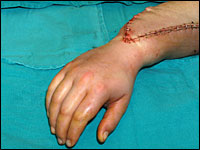
Courtesy of Jewish Hospital, Kleinert Kutz and University of Louisville
Savage’s story is rather touching, to say the least, and puts a kinder, human face on the harrowing Silver Spring monkeys epic that pushed neuroscience into the study of neuroplasticity and neurogenesis.

For NPR’s report on the neural implications of Savage’s hand transplant, go to:
http://www.npr.org/templates/story/story.php?storyId=95593579
For the story of the Silver Spring Monkeys , see Sharon Begley’s discussion in TRAIN YOUR MIND, CHANGE YOUR BRAIN, or Jeffrey Schwartz and Sharon Begley’s narrative in THE MIND AND THE BRAIN.
And for readers of SpaceSuit Yoga, the implications: The lessons of neuroplasticity are so far-reaching as to push us all to rethink and recontextualize our work, our creativity, our lives with respect to the innate power of our brains.
Wonders never cease!
Dr. G.
Tags:Brain and Hand Transplant, Brain Training with Yoga, Change Your Brain, Mind and Brain, Movement and Brain Training, Neurogenesis, NPR Brain Report, Silver Spring Monkeys, SpaceSuit Yoga, Train Your Mind
Posted in Body Maps, Brain Technologies, Brain Training, Mind/Brain Training, Neuroplasticity, SpaceSuit Yoga, Uncategorized | Leave a Comment »
September 23, 2008
The Platform: The State of U.S. Affairs, 2008
The Twitter: Shock, Fear and Dread in the U.S. (and abroad)
The Big Idea: There are no hopeless situations; only those who grow hopeless about them (George Greenstein, M.D., 1920-2005)
I’ve been receiving emails (and have sent a few myself) regarding the “shock” and “dread” from which people are reeling in light of the bail out crisis and media popularization of the Palin effect. So please allow me today to use this blog to address the neuroscience of “fear” and offer ways to change the neural setting in our brain to recognize the signals of creative problem-solving and hope.
There is no mistake that Barack Obama uses the term Hope, and more precisely, “the audacity of hope” in his attempt to reconnect American citizens to the core principles that shape a vibrant democracy, a politically and economically solvent society.

Obama’s cunning rhetorical move highlights the path of resistance to the Bush/Cheney SHOCK DOCTRINE that has waylaid many voices of contest and innovation, especially over the last eight years. What is the Shock Doctrine? Here I am drawing your attention to Naomi Klein’s THE SHOCK DOCTRINE: THE RISE OF DISASTER CAPITALISM, a thick, powerful study of the methods of shock used by students of Milton Friedman (e.g. Dick Cheney) to exploit the psychological and economic circumstances of crises and disasters.

My point is not to unpack Klein’s argument but to indicate a human and cultural pattern of response that we learn from reading Klein: When disaster strikes, shock takes over all body responses — breathing contracts, sweating begins, rational thinking becomes confused… for many, reason exits quickly out the door! An old and trust-worthy mammalian pattern has just set in: FEAR! For those who wish to take advantage, fear offers ideal conditions for exploitation. (Consider the logic: Fear responds to help.)
Turning to neuroscientists, we learn more about the neural conditions that create and perpetuate fear: Writing for Newsweek (Sept 15, 08) Dr. Michael Craig Miller, explains:
“Two deep brain structures called the amygdalae manage the important task of learning and remembering what you should be afraid of.”
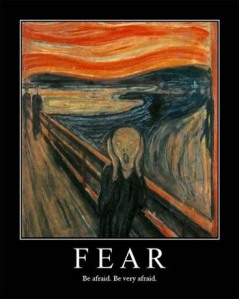
The amygdalae, it appears, function like good mental health turbo-networkers, rapidly collecting info that mobilizes the brain/body forces: heart rate, blood pressure, the capacity to reason. The two little clusters of neural networking also interface and connect with networks generating MEMORY.
“The fear system is extraordinarily efficient. It is so efficient that you don’t need to consciously register what is happening for the brain to kick off a response. If a car swerves into your lane of traffic, you will feel the fear before you understand it. Signals travel between the amygdala and your crisis system before the visual part of your brain has a chance to “see.” Organisms with slower responses probably did not get the opportunity to pass their genetic material along.”
Now the important paragraph that points to the generating pattern of collective shock and hysteria:
“Fear is contagious because the amygdala helps people not only recognize fear in the faces of others, but also to automatically scan for it. People or animals with damage to the amygdala lose these skills. Not only is the world more dangerous for them, the texture of life is ironed out; the world seems less compelling to them because their “excitement” anatomy is impaired.” (my emphasis)
Miller’s clarifying essay is just one of many to come down the pike, pointing out the DRAMATIC neuro consequences of being shocked by economic fallout and horrified of the short and long range possibilities of McCain/Palin in office.
So let’s connect the dots and do our simple brain math:
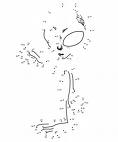
Frying in our own rage and gripped by the mighty handles of fear, our culture, our bodies, our speech, our minds entrain our brains into the rituals of fear: Fight or Flight.
Yet we are not mere mammals. Thanks to our highly evolved brain and thus the scientists, monks, somatic therapists who use their refined aptitude and skills to understand the brain/mind/body connection, we have learned a very important neural lesson that has large historical ramifications:
Fear is a response in the brain/body/mind. Change the brain and we change our body, our mind! Change our mind, our body and we change our brain!
To that end, and in service of offering a slice of whole-brain, somatic sanity to those hungering for a more judicious and delicious cultural pie, the following SpaceSuit Yoga tips for transforming Fear into Calm, Dread into Hope:
1) Practice a BIG IDEA: There are no hopeless situations, only those who grow hopeless about them.
2) Changing our brain begins with changing our breath.
Breath, after all, is the beginning and end of all human life.
To address a pattern of fear that has paralyzed one’s embodied brain and mind, go back to a daily practice of conscious, contemplative breathing. This blogsite offers tips on how to engage a simple practice of easy restorative breathing practices. (See the parent GGI website for links to other helpful meditation sites.
3) Breathing supports Initiation (Bonnie Bainbridge Cohen): To start any activity in your day, remember to notice what breathing actually feels like, what parts of the body are moved or involved in the process of breathing. Sturdy Breath enables A Sturdy Mind.
4) Mental Practice. With a calm and sturdy body/brain/mind, use your powers of Mental Practice to imagine a liberated landscape, a liberated body, an open space of movement and possibility. Picture hope, picture success.
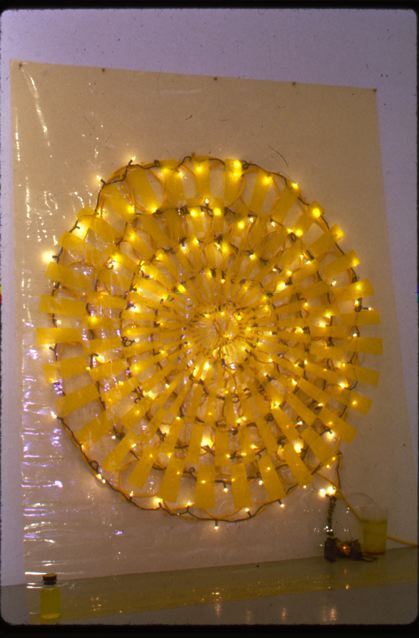
For the “how to’s” and the “go to’s” for stress reduction, breathing meditation and mental practice, please leave a comment or contact me by way of the GGI contact link.
May the Breath Be with you through this trying times!
Dr. G.
P.S. Check out the following sites that address or infer the neuro effects on the 2008 election:
1) http://dir.salon.com/topics/robert_burton/
2) google Newsweek and and search for Michael Craig Miller’s Newsweek essay noted above, entitled Sad Brain, Happy Brain) or go to http://samharris.org and search for the Miller piece.
Tags:Audacity of Hope, Breathing Meditation, Fearful brains, Meditation to Alleviate Fear and Dread, Meditations to reduce Fear and Anxiety, Mental Practice and Peak Performance, Michael Craig Miller M.D., Naomi Klein, Neuroplasticity and the voting, SpaceSuit Yoga Tips, The George Greenstein Institute, The History of Mass Hysteria, The Palin Effect, The Shock Doctrine, The U.S. Bail-Out Crisis, The Voter's Brain
Posted in Ancient/Future Technologies of the Body, Balancing the Brain Hemispheres, Body, Brain, Breath, Contemplative Education, Meditation, Mental Practice, Mind over Matter, Mindfulness Practice, Neuroplasticity, Neuroscience, Somatic, SpaceSuit Yoga, Uncategorized, Yoga | 3 Comments »
September 21, 2008
Quick Notice of Schedule change:
I just received word from Dr. Jill Bolte Taylor, noting her taped interview on the upcoming Sept 23 Oprah show is being postponed. No future date has been given.
As soon as I have word, I will be sure to share the updated news with all you somanauts!
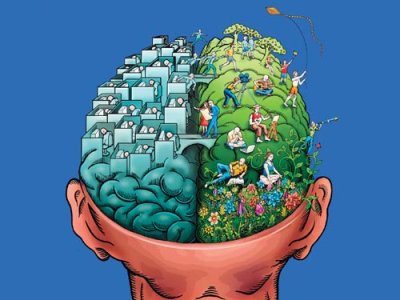
In the meantime, it’s reassuring to know that Dr. Taylor’s message has traveled wide and far as MY STROKE OF INSIGHT has been translated into 20 different languages! This is really important as translation brings to greater public awareness, the role contemporary neuroscience, and a personal commitment to healing plays in turning a tragedy into an inspiring story that uplifts and transforms other people’s lives.
Great week ahead! Stay Whole-Brained, Stay Hydrated and remember to Breath!
Dr. G.
P.S. Those interested in personal or corporate training in whole-brain health or neuro-leadership practices, please leave a comment or contact me through The George Greenstein Institute link (in the right hand column of this blog.
Tags:Balancing Right/Left Brain, Brain Injury, Jill Bolte Taylor, Meditation to Reduce Stress, My Stroke of Insight, Neuro-Leadership, Neuroplasticity, Neuroscience, Stroke, The George Greenstein Institute, Ways to Avoid Stroke, Whole Brain Health
Posted in Advances in Neuroscience, Balancing the Brain Hemispheres, Body, Brain, Brain Technologies, Brain Training, Breath, Meditation, Neuro-Aesthetics, Neuroplasticity, Right Brain Bliss, Right/Left Brain, TED 2008, Uncategorized | Leave a Comment »
September 18, 2008
The Platform: Anti-Aging Programs for the Brain
The Twitter: Pssst: Fluid Movement Rocks! (Indeed!)
The Big Idea: Movement changes the our brain and the brain changes our movement!
In this year of the brain, the term “neuro” has now entered the lexicon of leadership training, conflict resolution training, literacy training, the aesthetic education of musicians, visual artists and designers and as I have mentioned in this blog, the performance training of Olympic athletes. No longer curtailed to the hinterlands of scientific research or the once culturally detached province of brain-injury, the message of “neuro”, especially, “neuro-plasticity” is making its way through all dimensions of global urban life.
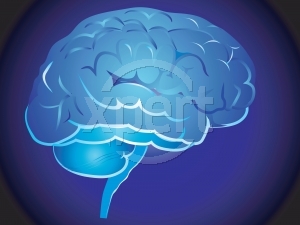 As I have noted on this site, the news of neuro-plasticity brings with it messages galore of how to update and change our brains. A casual survey of brain fitness programs reveals a trend: Exercise and Nutrition change the body and the embodied brain!
As I have noted on this site, the news of neuro-plasticity brings with it messages galore of how to update and change our brains. A casual survey of brain fitness programs reveals a trend: Exercise and Nutrition change the body and the embodied brain!
Now in the case of anti-aging advice, the brain/exercise connection is particularly dominant: Notice the examples that are given: aerobic exercise (for endurance and blood flow) and weight training (for balance and muscle strength).
But let’s put the neuro-mirror on the wall and connect the dots: What neuro-kinesthetic image of movement is being fed to the anti-aging public? A bouncing, muscle building body — one that ignores the change in joint fluids and over all sensory awareness of moving in space. One that ignores the neurally encoded body map and cognitive possibilities of expanding one’s range of movement!
bodiesinspace.com along with other sites dedicated to brain health and wellness have noted the need to debunk the myths of the unchanging brain. If exercise is going to be put forward as one of the ways to increase healthy brain tissue, I would encourage a rethinking of anti-aging and other brain fitness programs: Speak to the advantages of using fluid movement to increase joint and neuro-muscular tonicity and balance.
What is fluid movement? Think Tai Chi, Picture Belly Dancing, Imagine yourself on your “board” or floating on your back rocked by the waves of the ocean.

Fluid movement emphasizes curvilinear, serpentine or floating patterns in space.
Fluid movements “juice up” (i.e., lubricate) the joints — neck, spine, elbow, wrists, hip, knees and ankles.
Fluid movements stimulate the right brain, emphasizing spatial awareness.
Fluid movements make contact with the oldest, “pre-spinal” remnants of our bipedal evolution.
Fluid Movement, in other words, invites the brain to learn and recognize another aesthetic pattern of movement…. another pattern that allows us to adapt to and enjoy the world.
SpaceSuit Yoga Tip 1: Take a moment to observe things that move in a fluid manner. Now imagine yourself moving in the same way.
SpaceSuit Yoga Tip 2: Noted Somatic Pioneers of Fluid Movement: Emilie Conrad, Bonnie Bainbridge Cohen and Gabrielle Roth
SpaceSuit Yoga Tip 3: Check out the National Institute of Health, Alternative Medicine Research site for verifiable studies on the physiological effects of Tai Chi
http://health.nih.gov/topic/AlternativeMedicine (enter Tai Chi into the search area and click on the PDF)
So Connect the Dots: Fluid Bodies, Fluid Brains!
From the rolling shores of the great Pacific — May the Breath Be With You!
Dr. G.
Tags:Alternative Medicine, Anti-Aging, Baby Boomers, bodiesinspace.com, Body Maps, Bonnie Bainbridge Cohen, Brain Fitness, Center for Alternative Medicine, Emilie Conrad, Exercise for Anti-Aging, Fluid Movement, Gabrielle Roth, Joint Fitness, Movement for Seniors, National Institute of Health, Neuro-Aesthetics, Neuro-Leadership, Neuro-Mediation, Neuro-plasticity, Right Brain Training, SpaceSuit Yoga
Posted in Advances in Neuroscience, Balancing the Brain Hemispheres, Body, Body Maps, Brain, Evo-Devo, Neuro-Aesthetics, Neuroplasticity, Somatic, SpaceSuit Yoga | 3 Comments »
August 20, 2008
The Platform: 2008 Bejing Olympics
The Twitter: Brain Training for Gold Medals and more!
The Application: Meditation, Mental Practice, Attention and Awareness Training (AAT)

A recent article in the New York times noted Michael Phelps’s 3rd grade teacher extending congratulations to Phelps and his family for the gold medal success. As we learn, Phleps in his early years had the teacher worried that he had “no focus” in his studies. (What 3rd grader has “focus” in academic studies?!!!) With Phelps now drawing world-wide attention to the glory of his strategic swimming, the teacher apologies with a realization: Phelps just had to find the subject that drew out his focused attention.
Expectations of 3rd graders aside, Phelps’s victory is his to savor for years to come for he has proven to himself and to the world that consistent physical and mental training over time can transform our lives in ways that reach beyond our imagination.
 Clearly, Phelps and his swim team buddies have mastered the art and science of “concentration” or “focused attention” — practices that might be considered comparable to the astounding feats of attention practiced by Buddhist monks submitted to recent neuro-scientific studies. Turning to the neuroscience camp, we learn the years of focused attention, of bringing “mindfulness” to our actions makes significant neurological changes in the brain. As science writer Sharon Begley reminds us in TRAIN YOUR MIND, CHANGE YOUR BRAIN, the matter of morphing brain tissue comes down to a simple fact: You’ve got to want to change it for the brain to change.
Clearly, Phelps and his swim team buddies have mastered the art and science of “concentration” or “focused attention” — practices that might be considered comparable to the astounding feats of attention practiced by Buddhist monks submitted to recent neuro-scientific studies. Turning to the neuroscience camp, we learn the years of focused attention, of bringing “mindfulness” to our actions makes significant neurological changes in the brain. As science writer Sharon Begley reminds us in TRAIN YOUR MIND, CHANGE YOUR BRAIN, the matter of morphing brain tissue comes down to a simple fact: You’ve got to want to change it for the brain to change.
No doubt, Phelps and his crew wanted to break records, win gold medals, perform at the top of their game. The reason for such bold desire? We can leave that to enlightened or nefarious speculation, for the real story here is this: Hot, passionate, and inspired human desire enables dedicated action. Dedicated Mental Practice transforms the brain….and body.
I vote for inviting Phelps and the American men’s swim team into the brain labs of UCLA, University of Washington, or Wisconsin to test their neuronal abilities to “pay attention.” And then let’s bring in full tilt Olympic education into the school system so that 3rd graders can be inspired to do their thing.

Michael Phelps: You Go Girl!
And to all of the somanauts out there, a SpaceSuit Yoga tip for mental practice:
1) Best way to begin: Pay close and intimate attention to breathing, whether you’re walking, swimming, or lying down. Notice the feeling of breathing — whether breathing takes up a lot of room or very little room, whether breathing feels fast or slow. Visualize breathing — get a sense of where it actually takes place in your body.
2. Set aside a little time each day to “pay attention” to your breath and use a timer, so you don’t have to keep track of the minutes. Master one sequence of time before adding more minutes.
Master one sequence of time before adding more minutes.
3. Keep a written record of your time so you can 1) notice the sequence of improvements and 2) make a felt, embodied connection between your inner sense of mastery with an outer account of recorded time.
4. Invigorate yourself with reading on how to motivate and change your brain! Several suggestions have already been noted in this blog. For history buffs — check out the “Zen and the Art of Archery” — a classic on mental practice and meditation.
May the breath and brain be with you!
Dr. G.
Tags:2008 Bejing Olympics, Meditation and the Brain, Mental Practice and the Brain, Mental Practice, Michael Phelps, Sports Training, Training of Olympic Athletes, Zen and the Art of Archery
Posted in Advances in Neuroscience, Body Maps, Brain, Breath, Meditation, Mental Practice, Mind over Matter, Mindfulness Practice, Neuro-Respiration Technologies, Neuroplasticity, Neuroscience, Somanauts, SpaceSuit Yoga | 1 Comment »
August 9, 2008
The Platform: AUSTRALIA, 2008
The Twitter: The Brain Makes Culture; Culture Makes the Brain
The Application: Art and Design
It’s a rainy afternoon in Melbourne Australia and the subject of the embodied brain finds new avenues of discussion. I am down under, here to lecture on “neuroaesthetics in art and design” at universities in Sydney and Melbourne, where the question of the ënculturated brain has come to the fore: Sitting at the Chocolate Buddha Bar, eating yummy gyoza and kingfish sashimi, I had the chance to speak with a couple who took an interest in the idea that art has a direct”, phenomenal impact on the actual neural structure of the brain. They posed the question: What affect do different cultural art forms have on the human brain? Or to ask it another way, are Australian or Chinese brains different if they are raised on a different set of visual images?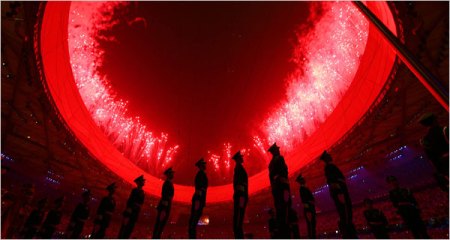
If anyone was watching the opening ceremony of the 2008 Summer Olympics, one might be quick to say, the proof is in the pudding! Thousands of years evolution have clearly contributed to the neural networking that produced Chinese trapeze and firework aesthetics! But does that mean Chinese brains are structurally different than Australian brains?
Neurologists of art and neuro-aesthetes tell us that “the brain makes culture and culture makes the brain. The reciprocal feedback that takes place during the course of an artist’s education is bound to take on both neural and cultural dimensions, especially where values of light, space, color, line, scale — the fundamentals of visual composition are concerned. Likewise, the novel human experiences like watching the bedazzling opening Olympic ceremony surely affects the brain, especially if one has never seen Chinese art, Chinese film, Chinese opera, or experienced the thrilling spectacle of fire-works. Novelty, after all, is a hall-mark motif of those conditions that are ripe for changing brains. (Think of the Anti-Aging Benefits!) Newness, the “first ëncounter,” the stunning effect of unique invention –graps our ear and our eye and most assuredly our brain!
To the extent that neurologists can detect the differents in the ways in which different cultural traditions affect the human brain, is the extent to which we can begin to understand the value of culture and cultural tradition in training the brain. Let us remember that as humans, we phylogenically share the potential to grow a brain with the same structural and developmental likeness, and with the structural capacity for neuroplasticity. And as a specie, we have the capacity to grow a neural network that challenges our ethnocentric inclinations and enables us to share language, food, music, images, sport — and as my good Ozzie compadre Nick Tsoutas reminds me — love. (If you’re in Sydney, check out Nick’s latest efforts at Casula Powerhouse, entitled “Äustralian”.)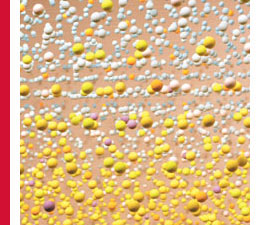 “Nike Sawas, “Ätomic full of love, full of wonder”
“Nike Sawas, “Ätomic full of love, full of wonder”
SPACE SUIT YOGA LATE SUMMER/WINTER Neuroaesthetic TIP: Seek Novelty! Expand Your Brain!
*Travel down under (or to any “foreign” country for that matter)
*Learn a new language
*Test out your mind’s eye on a challenging piece of art
*Play Suduko during a 13 hour trip to Oz
*Surf the great oceans of the world! (For you Ozzies, compare L. A. surf to Sydney Surf; for all Northern Hemisphere folks, check out the azure blue waters of Bondi!)
From Aussieland, where the most civilized and the most ancient meet ….. may the breath be with you! And in these days of Olympic contest and glory, may all brains be inspired to make culture so that culture inspires the growth and well-being of the each and every embodied brain!
Zoom Zooom!
Dr. G. a.k.a. M. A. from L. A.
Tags:Anti-Aging Tips, Art and the Brain, Australian Brains, Brain and Culture, Casula Powerhouse, Chinese Aesthetics, Chinese Brains, Chinese Summer Olympics, Design and the Brain, Dr. G., Neuro-plasticity, Neuroaesthetics, Nick Tsoutas, SpaceSuit Yoga
Posted in Art and the Brain, Body, Brain, M. A. from L. A., Neural Networks, Neuro-Aesthetics, Neuroplasticity | Leave a Comment »
July 20, 2008
The Platform: Mindshare.la
The Tweeter: EVO DEVO
The Application: Spinal Cord Mapping
BIG IDEA 1: Innovation and Sustainability are necessary competing and collaborative values of evolutionary anatomy.
Big IDEA 2: The spine supports our bipedal transit through space and houses our peripheral nervous system, enabling or deterring the liveliness of vital organs and the systems that regulate them.
Big Somanautic IDEA: The spine is interdependent and intimately networked with the brain/mind/body.
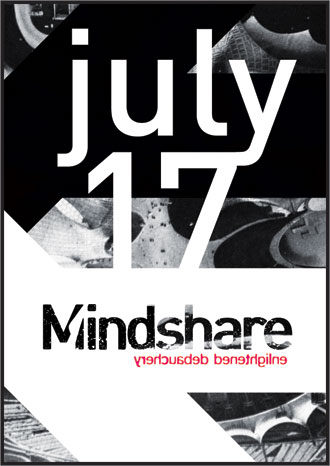
In the year of the brain, social networking brings neuro to the fore of tweeters, blogs and raves! A case in point. Mindshare.la organized by visionary entrepreneurs Doug Campbell, Justin Pichetrungsi and Adam Mefford, is a 21st century forum of “enlightened debauchery” taking place monthly at the L. A.’s Brewery complex. The event staged on the 4th floor loft of an old brewery building, draws to it a cadre of cutting edge designers, techies and scientists from the networked brain trust of So. Cal. universities and art schools.
On Thursday, July 17, the Brewery loft was buzzing with futurist ideas and stunning design moments in self expression: Seamstress Erin wafting through room in her orange parachute evening dress, Sarah Dunbar Rhodes Design’s new line of gold and Swarovski crystal jewelry as multi-faceted and sparkling as the conversations in the room. As for inspired tech-logic, last night’s presentation included a rapid-fire talk on Evo-Devo by futurist John Smart. While the changing morphology of the spine was not the point of Smart’s rhetorical pitch on cultural acceleration, his comments on Evo-Devo gave me pause as to the effects of evolution and development on the peripheral nervous system.
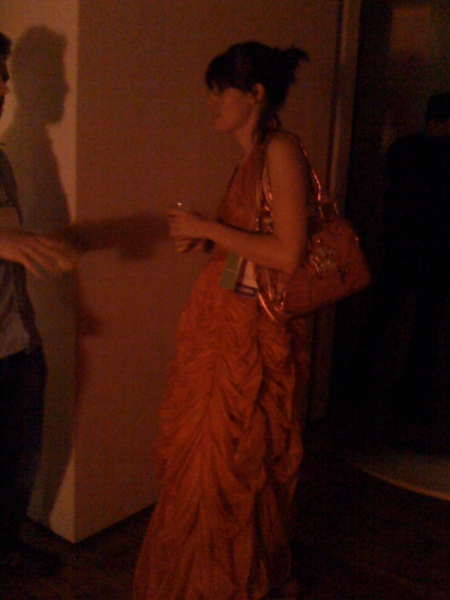
Seamstress Erin
To this point: A recent posting from the Seattle Times announced a new spinal cord atlas is in the works. The Allen Institute for Brain Science at the University of British Columbia is releasing the first of its data on spinal cord mapping. Spinal cartography enables neuro-biologists to study in greater depth, the cellular territory of neural tissue in the peripheral nervous system.
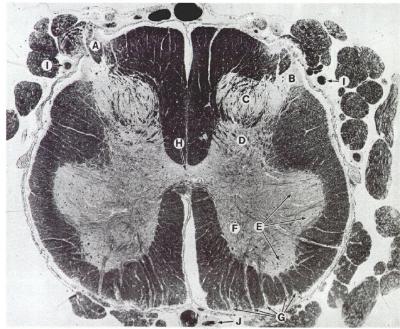
Spinal Cord at the level of the lumbarsacral enlargement
“It will enable us to look inside each group of cells in the spinal cord and know what it is that makes them special and different from the cells around them,” said [Jane] Roskams, of UBC’s Brain Research Centre. “I don’t think there will be a lab in the world working on spinal-cord injuries that does not access this as soon as it goes online.”
[See http://seattletimes.nwsource.com/html/localnews/2008056228_allenbrain17m.html%5D
Pushed front and center into neuro-celebrity, the spinal cord deserves the GGI and SpaceSuit Yoga’s attention given its place in the unfolding Evo-Devo story of brain science. From the standpoint of evolution, the spine carries the morphological coding of its unique genetic, neurological and anatomical history. From the standpoint of actual development in one lifetime, the spine grows and must be maintained in order to fortify bipedalism and safely house the peripheral nervous system – the system of signals and reflexes codes that turn on and off the vitality of our VITAL ORGANS. . Think of spinal Evo-Devo in terms of orthopedic and kinesthetic effects: the ergonomic adjustments that had to come from moving on all fours to walking upright!
For you somanauts out there, mapping the spinal cord holds tremendous promise in the fields of regenerative and restorative medicine and the broad spectrum of healing arts. Imagine what the spinal map will do the treatment of spinal cord injury, as well as for the fields that work hands on with spinal liberation and adjustment, e.g. Chiropractic, Cranial Sacral, Feldenkris, and the many Yogas and Martial Arts. A somatically enlightened Evo-Devo lab on spinal anatomy would, in other words, urge us to reckon with both evolutionary innovation of human anatomy and sustainable maintenance of normative spinal development throughout a lifetime. SpaceSuit Yoga Suggestions: Spinal breathing, Spinal rolls, gentle back bends – any and all juicy wave like, undulating movement that lubricates the spinal and related joints with cerebral-spinal and synovial fluid!
Rock and Roll,
Dr. G.
Tags:Advances in Neuroscience, Evo-Devo, Mindshare.la, Spinal Cord Atlas, Spinal Cord Mapping
Posted in Advances in Neuroscience, Ancient/Future Technologies of the Body, Body Maps, Brain, Evo-Devo, Neural Networks, Neuroplasticity, Neuroscience, Somanauts, Somatic, Spinal Cord Injury, Spinal Cord Mapping | 3 Comments »
May 14, 2008
Well, May has rolled into town. The jacarandas are turning Los Angeles into a “purple haze” and the star jasmine buds send wafting scents of Pacific Rim sweetness into the air.
As seasons change, so does the discussion regarding neuroscience and its far reaching affects visual art, literature and religion. As all of the authors suggest, one gets the feeling that we’re clearly in the midst of revolution, with Frankensteinian fantasies that loom large. For your pleasure and curiosity, an article and books of note:
1. Today the New York Times ran an online article by David Brooks entitled “The Neural Buddhists.” Brooks ponders the limits of a materialist perspective held by 20th century scientists in light of the cognitive, existential and religious implications of neuro-plasticity. His claim? The debate between science and religion is moved into the non-reductivist territory of “neural-mysticism.” (Sadly, here again we see mysticism used as the over-arching frame for Buddhist practice — which by the way is recognized as a religious practice throughout Asian countries.)
See: OPINION | May 13, 2008
Op-Ed Columnist: The Neural Buddhists
By DAVID BROOKS
The cognitive revolution is not going to undermine faith in God it’s going to challenge faith in the Bible.
2. Art historian Barbara Marie Stafford has published her thoughts on neuroscience and art history in her latest book ECHO OBJECTS, a frothy, in depth study of art history from a neuro-aesthetic perspective. Stafford, influenced by my colleague Warren Neidich, takes his “brain makes culture, culture makes the brain” thesis and translates its implications into a claim for the reciprocal alignment between neuroscience and the humanities.
3. SEED Magazine editor in chief Jonah Lehrer takes on the art and humanities, especially the “lit crit” crowd in his first book PROUST WAS A NEUROSCIENTIST. Lehrer, trained in neuroscience and literature, joins critical thinker Brian Massumi to claim we don’t need to know neuroscience to make or understand the mysteries of art but we sure can learn some fascinating stuff about the brain if we do so! I depart from Leher and Massumi as I’ve found, by sharing neuroscience insights with art students regarding the relations between the visual and soma-sensory cortex), light-bulbs of thinking brighten… and new perspectives about 2-d and 3-d media come about.
The question of how we study neuroscience and to what end remains before us: In an age that celebrates the autodidact and the social networking of learning, surely a little look under the hood of our own “minds” couldn’t hurt.
As far as I’m concerned, Dr. Frankenstein, feel free to enter and teach us what you’ve found!
May the Breath and the Creative Brain be with You!
Dr. G.
Tags:Add new tag, Art and the Brain, Proust Was a Neuroscientist, Religion and the Brain
Posted in Art and the Brain, artistic genius, Barbara Stafford, beauty, Creativity and the Brain, Jonah Lehrer, Literature and the Brain, Neuro-Aesthetics, Neuroplasticity, Proust Was a Neuroscientist, Religion and the Brain, Seed Magazine | Leave a Comment »
January 2, 2008
2008 is the Year of the Brain 

 http://faculty.washington.edu/chudler/neurok.html
http://faculty.washington.edu/chudler/neurok.html
2007 may have been a tough one for the global climate, global unrest and global media but whew!… What a year for the global (and local) Brain! With the news of “neuroplasticity” to hit the radio, newspapers and book-stores (it’s already all over the WEB), somatic arts and science will never be the same.
With this in mind, I am dedicating this year of SpaceSuit Yoga blogs to sharing all that continues to come my way from the expanded fields of neuroscience and neuro-aesthetics. The first is a highly suggested reading that dovetails Sharon Begley’s TRAIN YOUR MIND, CHANGE YOUR BRAIN, namely THE BODY HAS A MIND OF ITS OWN, by Sandra Blakeslee and Matthew Blakeslee. Some of you may remember S. Blakeslee’s co-authoring Ramachandran’s 1998 tour guide through the brain. Her new book, written with her son, covers the breadth of neuroscientific research that brings somatics, mythopoetics and the psycho-physiology of human transformation up to date.
In months to come, I will elaborate on these issues and invite colleagues to join me expanding the ways in which we can relate these ideas to real time, creative thinking and action.
For time being, a SSY train your brain/mind tip for faking out the stress of New Year’s resolutions:
1. Don’t make any.
2. Instead, sit down for 5 to 20 minutes, close your eyes and tune inside to your physical, sensual experience of breathing.
3. Next, picture the action, the vitality of performing the goal you have in mind. Picture yourself accomplishing your goal.
4. Continue to be physically “present” with breathing and continue imagining the action you wish to perform.
5. Take one large deep breath, let it out. When you feel ready, open your eyes and go about the business of your day.
This process of contemplation or mental practice is reinforced through repeated practice. For more info, check out the suggested readings or write me at 2docgee@gmail.com
A Happy and Healthy New Year To All!
M. A. from L. A. a.k.a. Doc. G.
Tags:Change Your Brain, Neuro-Aesthetics, Sandra Blakeslee, Sharon Begley, SpaceSuit Yoga Meditation, The Body Has a Mind of Its Own, Train Your Mind
Posted in Body Maps, Contemplative Education, Creativity and the Brain, Meditation, Mental Practice, Mindfulness Practice, Neuro-Aesthetics, Neuroplasticity, Yoga | 2 Comments »
June 18, 2007
Play-Doh and the Brain
What does Play-Doh have in common with the human brain?
A strange question for those in the field of neuroscience but for the Play-Doh artists of yesteryear as well as today, the query makes a kind of intuitive sense. Play-Doh, after all, was and remains one of the first (non-toxic) malleable stuff we get to smooosh, jab, twist, learning the very important sensory lesson of plasticity. (For you Freudians, even our own “doo” doesn’t have that kind of moldability!)
Now granted the kind of plasticity said to be native to the brain is not geared toward hands-on sculpting, although there are days when some of us feel like our brains have been through the Play-Doh press. But for those of us who remember the power we felt manipulating the soft, rubbery and colorful stuff, the untold possibilities of neuroplasticity hold immense promise.
As a young grad student in dance and movement therapy studying sensori-motor and imagination capabilities of the brain, the first inklings of neuroplasticity came forward in the discussion of mental practice. I remember flying to Chicago with a colleague to interview Dr. Edmund Jacobson, whose research on mental practice and relaxation response had greatly influenced my mentor Dr. Alma Hawkins. Hawkins was a visionary in her own day, bridging the history of mystical practice (meditation), creativity and neuroscience in hopes of coming up with an empirically ground pedagogy for young dance and movement therapy students.
Today, meditation and mental practice are both at the heart of neuroscience research and as we are learning, its effects on neuroplasticity is helping to turn over nearly two centuries of scientific studies built on the mechanistic premise that nerve cells are non-adaptive and that the functional organization of the brain is fixed and unchanging.
Call it Play-Doh for the brain, but I say the story of neuroplasticity is the best news to break in the arts, education, sports, health and fitness. For you somanauts, the orbit and directive have both been made clear: “The brain makes culture and culture makes the brain” (Warren Neidich). So “train your mind; change your brain” (Sharon Begley).
By the way, for those interested in testing their neuroplastic potential this summer, check out the Aging Body (or not) workshops that will be held in August in the Rocky Mountains! See http://www.spacesuityoga.com and click on Summer Workshops.
The future is ours to mold!
Dr. G.
*For those working with students grades K-12, be sure to read the recent NY Times article (June 16, 2007), on the skillful use of mindfulness practice in elementary schools and hospitals, to the benefit of participating students.
http://select.nytimes.com/mem/tnt.html?emc=tnt&tntget=2007/06/16/us/16mindful.html&tntemail0=y
Tags:Change Your Brain, Meditation and Neuroplasticity, Neuroplasticity, Play-Doh and the Brain, Train Your Mind
Posted in Meditation, Mental Practice, Neuroplasticity | 4 Comments »


 Bio:
Bio: 



